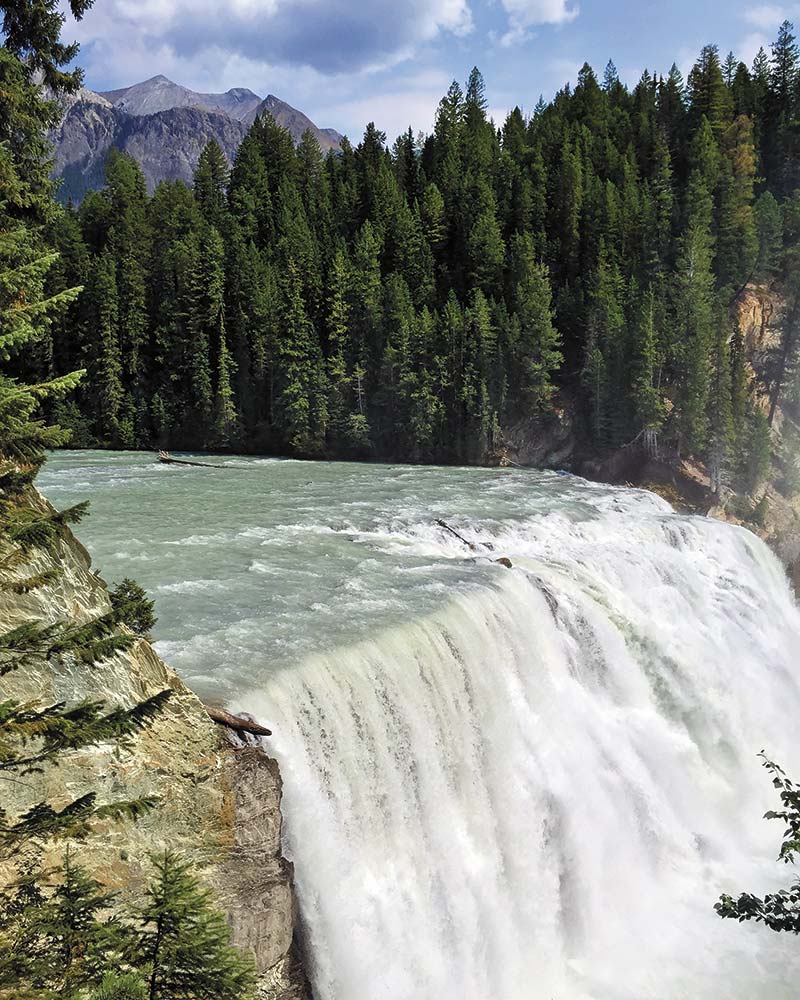
Getting to Kamloops and the B.C. Rockies
Mount Revelstoke National Park
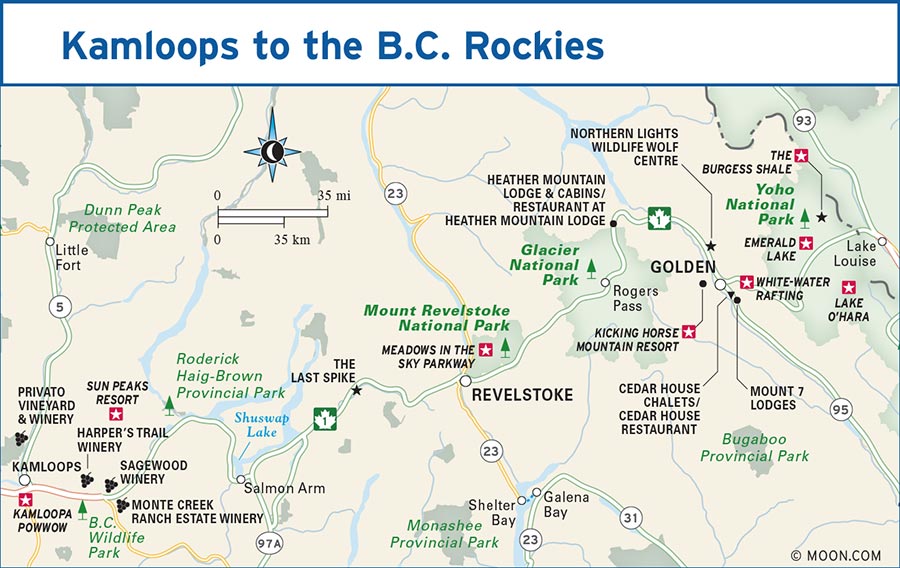
The Trans-Canada Highway takes you from the desertlike hills of British Columbia’s interior to the evergreen forests and stark alpine peaks of the Rockies.
Midway between Vancouver and the Rockies, the city of Kamloops makes a logical road-trip stopping point, with several small museums, emerging wine and craft beer industries, and plenty of desert sunshine. Nearby, Sun Peaks Resort offers hiking and cycling along its rolling hills in summer and more than 130 trails for skiing and snowboarding once the snow starts to fall.
As you continue east, Highway 1 climbs through the Purcell and Selkirk mountain ranges en route to the Rockies, passing directly through three striking national parks. Mount Revelstoke, Glacier, and Yoho have plenty of scenic drives, numerous hiking trails, shimmering glacier-fed lakes, and one of Canada’s highest waterfalls. Important in Canada’s early development, particularly its transcontinental railroad, the mountain towns of Revelstoke and Golden are good bases for exploring the parks, with outdoor activities, cool restaurants, and comfortable places to spend the night.
From Vancouver to Kamloops, the most direct route is to take the Trans-Canada Highway (Hwy. 1) east to Hope. Continue east at Hope onto Highway 3, then exit onto Highway 5 (Coquihalla Hwy.) north. Follow the Coquihalla over the mountains to Kamloops. It’s 220 miles (355 km) from Vancouver to Kamloops via this route, which takes 3.75-4 hours.
An alternate route from Vancouver to Kamloops takes you through the scenic Fraser Canyon. Take Highway 1 to Hope and continue north on Highway 1 through Boston Bar and Cache Creek, where the highway turns east to Kamloops. This Fraser Canyon route is 270 miles (430 km) from Vancouver to Kamloops and it takes five hours.
If you’re heading on to the Rockies from Kamloops, pick up Highway 1 in Kamloops, which continues east to Revelstoke, Golden, and Yoho National Park. The drive from Kamloops to Revelstoke is 135 miles (215 km) and takes 2.5 hours; from Kamloops to Golden, it’s 225 miles (360 km) and takes four hours; from Kamloops to Yoho, it’s 260 miles (415 km) and takes 4.75-5 hours.
If you want to stop off in Whistler between Vancouver and Kamloops, take the following route. After driving Highway 99 (Sea-to-Sky Hwy.) from Vancouver to Whistler, continue north on Highway 99. It will join Highway 97, and at Cache Creek, you’ll meet up with the Trans-Canada Highway (Hwy. 1) east to Kamloops. This Vancouver-Whistler-Kamloops route is 260 miles (420 km) and takes 5.75-6 hours; the Whistler-Kamloops leg is 185 miles (295 km) and takes four hours.
Driving from Kelowna, in the Okanagan wine region, to Kamloops, you have two options: Follow Highway 97C west to Merritt, where you pick up Highway 5 to Kamloops; this route is 130 miles (210 km) and takes you through some beautifully remote ranchlands. Or take Highway 97 north, which forks to the northwest and continues to Kamloops; this second option is 105 miles (170 km) and follows some scenic stretches of lakeshore. The Merritt route is longer, but the roads are faster. Either option will take about 2.5 hours.
From Kelowna to Revelstoke, Golden, or Yoho, take Highway 97 north, then continue north on Highway 97A. At Sicamous, turn east onto the Trans-Canada Highway (Hwy. 1), which leads east to these mountain destinations. The trip from Kelowna to Revelstoke is 125 miles (200 km) and takes 2.5 hours.
The Trans-Canada Highway (Hwy. 1) is the direct route from Banff to British Columbia. The road will take you west into B.C. to Yoho, Golden, Revelstoke, and Kamloops. The drive from Banff to Yoho is 55 miles (85 km) and takes one hour. From Banff to Kamloops, it’s 310 miles (495 km) and takes 5.5-5.75 hours.
The shortest route between Jasper and Kamloops is to follow Highway 16 (Yellowhead Hwy.) west to Highway 5, where you turn south toward Kamloops. The trip from Jasper to Kamloops via this route is 275 miles (440 km) and takes five hours.
A longer but scenic route is to take the Icefields Parkway (Hwy. 93) south from Jasper to Lake Louise, where you turn west onto Highway 1. You’ll pass through Yoho, Glacier, and Mount Revelstoke National Parks and into the city of Kamloops. The drive from Jasper to Yoho National Park via this route is 160 miles (255 km) and it takes 3.5-4 hours. Driving this scenic route from Jasper to Kamloops, the trip is 415 miles (665 km) and takes 8.25-8.75 hours.
The most convenient way to get to Kamloops from most B.C. or Alberta destinations is with your own vehicle, although there are options to fly or take the train. To reach any of the B.C. national parks easily, you need a car.
Air Canada (888/247-2262, www.aircanada.ca) flies to the regional Kamloops Airport (YKA, 3035 Airport Rd., 250/376-3613, www.kamloopsairport.com) from Vancouver and Calgary. WestJet (888/937-8538, www.westjet.com) serves Kamloops from Calgary. Central Mountain Air (888/865-8585, www.flycma.com) flies to Kamloops from Edmonton and from several northern B.C. communities, including Fort St. John, Prince George, Smithers, and Terrace. The airport is 7 miles (11 km) west of downtown Kamloops.
Budget Car Rental (250/374-7368 or 888/368-7368, www.budget.ca), Enterprise Rent-a-Car (250/376-2883 or 888/305-8051, www.enterprise.com), and National Car Rental (250/376-4911, www.nationalcar.ca) have offices at the Kamloops Airport.
The Canadian, the VIA Rail (514/989-2626 or 888/842-7245, www.viarail.ca) Vancouver-Toronto train, stops in Kamloops. You can travel westbound to Vancouver or eastbound to Jasper and points farther east, including Edmonton, Saskatoon, Winnipeg, and Toronto. However, between Vancouver and Kamloops (9.5-13 hours) or between Kamloops and Jasper (9-10 hours), the train is significantly slower than driving. The Canadian operates three times a week in each direction May-mid-October, and twice a week mid-October-April.
Its name comes from T’kemlups, a Secwepemc First Nations’ word meaning “the meeting of the rivers.” Kamloops, a city of 90,000 at the confluence of the South Thompson and North Thompson Rivers and at the intersection of Highways 1, 5, and 97, is a convenient stopping point when you’re traveling across the province. This dry region has a hot, almost desertlike climate in summer; it gets an average of 8.6 inches (218 mm) of rain every year, compared with more than 43 inches (1,100 mm) in coastal Vancouver. The city has several small museums, emerging wine and craft beer industries, and lots of sunshine.
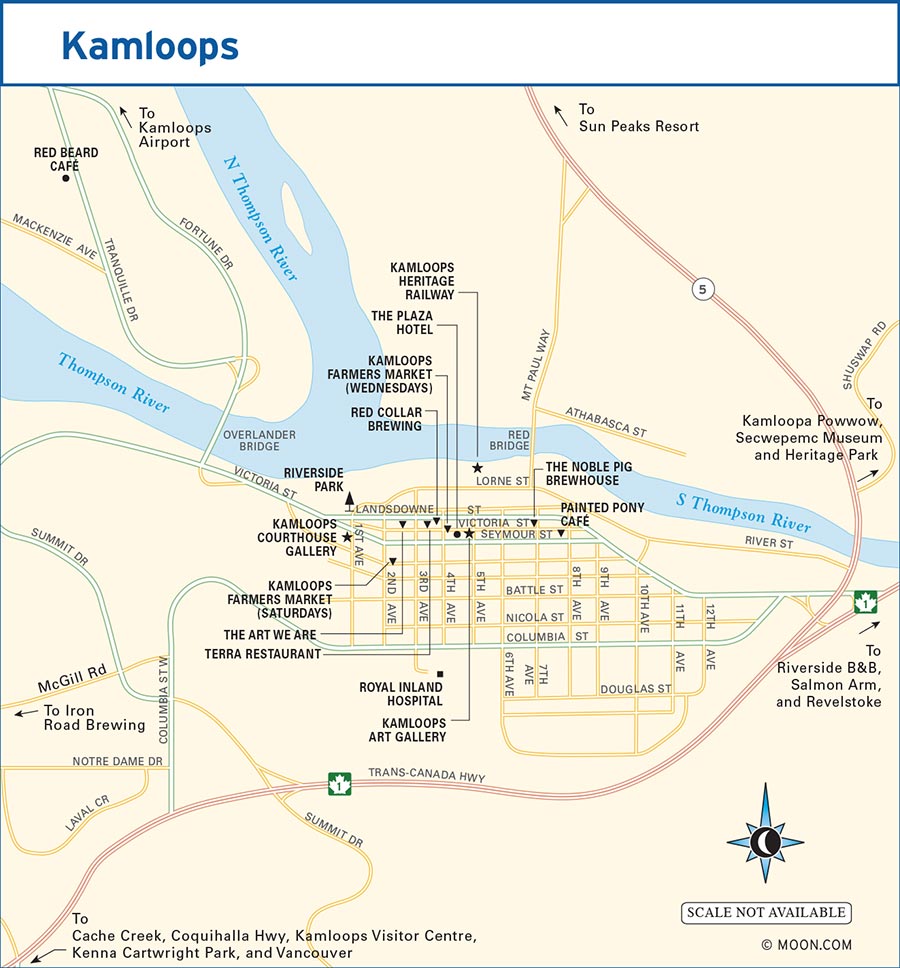
A residential school for aboriginal children operated from the 1890s to 1978 on the grounds of what is now the Secwepemc Museum and Heritage Park (200-330 Chief Alex Thomas Way, 250/828-9749, www.secwepemcmuseum.com, 8am-4pm daily, adults $10.50, seniors and students $7.35, ages 7-17 $6.35, families $21), first in a wooden schoolhouse and later in the 1920s redbrick building that still stands on the site.
The museum details the history of the Shuswap First Nation (Shuswap is the English name for the Secwepemc people), whose traditional lands cover 56,000 square miles (145,000 sq km) between the Fraser River and the Rocky Mountains. Take time to read the details in the exhibits that feature regalia and other clothing, dugout canoes, profiles of chiefs and other band members, facts about the Shuswap language and culture, and information about residential schools, both here and elsewhere in B.C.
Ride back in time on the Kamloops Heritage Railway (250/374-2141, www.kamrail.com, July-Aug., call or check the website for schedules, adults $25, seniors $22, ages 3-17 $15, families $70), as a restored 1912 steam locomotive pulls rail cars through the desertlike hills outside the city on an hour-long, family-friendly tour. Don’t be alarmed if horseback-riding “bandits” hold up your train in a simulated robbery.
You can buy tickets online or in person from the ticket office outside the former Canadian National Railway station (510 Lorne St.), where the rail tour starts and ends.
Stop into the contemporary building in downtown Kamloops that houses the Kamloops Art Gallery (465 Victoria St., 250/377-2400, www.kag.bc.ca, 10am-5pm Mon.-Wed. and Fri.-Sat., 10am-9pm Thurs., adults $5, seniors $3, families $10) for exhibits of works by regional artists, including indigenous artists. Admission is free on Thursdays.
Kamloops Courthouse Gallery (7 W. Seymour St., 250/314-6600, www.kamloopscourthousegallery.ca, 10am-5pm Tues.-Fri., 10am-4pm Sat.), a local artists’ cooperative, shows and sells work by its members in the stately former provincial court building that dates to the early 1900s.
On the South Thompson River in downtown Kamloops, Riverside Park (Lorne St.) has a sandy riverside swimming beach with a splash park for the kids, as well as changing rooms and restrooms. The park also has a rose garden and a riverfront walking trail. Every evening in July and August, at the park’s Rotary Bandshell, there’s Music in the Park (250/828-3611, www.tourismkamloops.com, 7pm daily July-Aug., free), a series of free 90-minute concerts.
To see more of Kamloops’ desert surroundings, take a hike on the 25 miles (40 km) of trails in Kenna Cartwright Park (2000 Hillside Dr., www.kamloops.ca, dawn-dusk daily, free), which at 1,975 acres (800 ha) is the largest municipal park in British Columbia. For a moderate route up to a lookout over the city and the river, follow the Prickly Pear Cactus Trail to the Powerline Trail to the Sunset Trail, an out-and-back hike that totals about 3 miles (5 km).
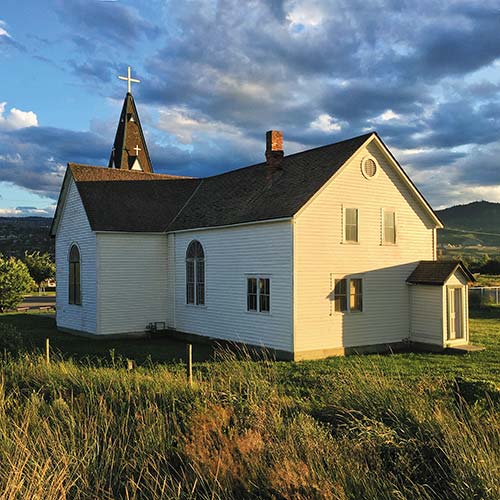
church along the route of the Kamloops Heritage Railway
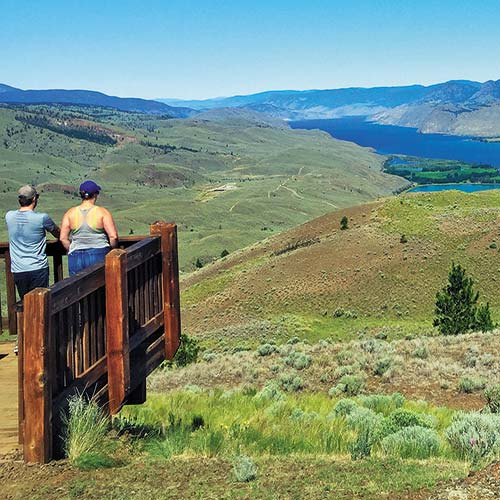
Kenna Cartwright Park
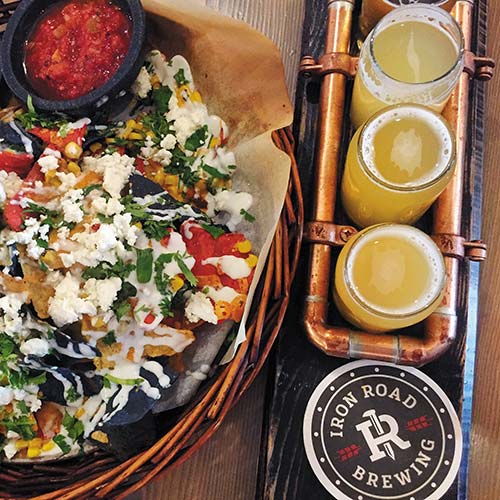
nachos and beer at Iron Road Brewing
If you’re hoping to see Canadian wildlife as you journey across the region, start at the nonprofit B.C. Wildlife Park (9077 Dallas Dr., 250/573-3242, www.bcwildlife.org, 9:30am-4pm daily Mar.-Apr., 9:30am-5pm daily May-early Oct., 9:30am-4pm Sat.-Sun. early Oct.-Feb., adults $15.95, seniors $13.95, ages 3-17 $11.95, families $49.95), where wolves, coyotes, moose, elk, eagles, owls, and other animals live in large outdoor enclosures. You may even glimpse the rare white Kermode or “spirit” bear that’s native to the B.C. coast.
The best time to visit the wildlife park, which has little shade along its pathways, is in the morning or on a cool or overcast day. On summer afternoons, the animals take shelter from the strong desert sun, and so should you. The park is 12 miles (20 km) east of Kamloops, off Highway 1.
While the wine-making industry in the Kamloops area is a drop in the wine cask compared to the well-developed wineries in B.C.’s Okanagan Valley, you can stop and sip at several local vineyards.
The first winery in the Kamloops region, Harper’s Trail Winery (2761 Shuswap Rd., 250/573-5855, www.harperstrail.com, 11am-5pm daily late Apr.-Sept., 11am-5pm Fri.-Sun. early Oct., tastings $5) released its initial vintage in 2011 and now produces riesling, pinot gris, cabernet franc, and other varieties that you can sample in the wood-paneled tasting room. Picnickers are welcome on the wraparound patio facing the vineyards and desert hills. The winery is 12 miles (20 km) east of downtown Kamloops. Taking Highway 1 is a little faster, but the drive along Shuswap Road past the desert cliffs and hoodoos is more scenic.
Credited with coining the phrase, “Hands up!,” notorious train robber Billy Miner held up his last Canadian train in 1906 on the ranchlands that now house Monte Creek Ranch Estate Winery (2420 Miner’s Bluff Rd., Monte Creek, 250/573-5399 or 855/633-9463, www.montecreekranchwinery.com, 10am-6pm daily May-Oct., 11am-5pm daily Nov.-Apr., tastings $5). This Wild West history inspired the winery’s Hands Up varieties, including a white blend of frontenac blanc, viognier, and la crescent grapes, and a red made primarily from merlot, marquette, and cabernet sauvignon. The tasting room, 20 miles (33 km) east of Kamloops along Highway 1, is in a striking, modern barn-inspired structure with a landmark bell tower, with views of the Lions Head rock face, desert headlands, and surrounding vines. On the Terrace, the winery’s outdoor wine bar, you can sip wine while nibbling cheese or charcuterie.
Also east of town, Sagewood Winery (589 Meadow Lark Rd., 250/573-1921, www.sagewoodwinery.ca, 1pm-5pm Wed.-Sun. mid-June-Oct., call for off-season hours, tastings $5) makes riesling, gewürztraminer, pinot noir, and other wines.
At Privato Vineyard & Winery (5505 Westsyde Rd., 250/579-8739, www.privato.ca, 10am-5pm daily May-mid-Oct., 11am-4pm Wed.-Sun. mid-Oct.-late Oct., by appointment Nov.-Apr., tastings $7), an 80-acre (32-ha) family-run farm west of downtown that produces chardonnay, pinot noir, and rosé wines, you can purchase a picnic basket to enjoy with a glass of wine in the flower-filled garden.
Try a tasting flight of house-brewed beers at The Noble Pig Brewhouse (650 Victoria St., 778/471-5999, www.thenoblepig.ca, 11:30am-11pm Mon.-Wed., 11:30am-midnight Thurs.-Sat., 3pm-10pm Sun.), a downtown brewpub and eatery where you might sample the Fascist Pig Pilsner, Wallonian Pig Belgian Peppered Ale, or the easy-drinking House Lager.
Another downtown craft beer maker with a laid-back pub-style tasting room, Red Collar Brewing (355 Lansdowne St., 778/471-0174, www.redcollar.ca, 5pm-10pm Tues.-Wed., 3pm-10pm Thurs.-Fri., 1pm-10pm Sat.) typically has 10 brews on tap, including a medium-bodied blonde, a dark Belgian-style dubbel, and seasonal beers like a Cherry Sour.
The co-owners of Iron Road Brewing (980 Camosun Cres., 778/765-8160, www.ironroadbrewing.ca, noon-10pm Mon.-Thurs., noon-midnight Fri.-Sat., noon-9pm Sun.) left their jobs as geologists, since as big beer drinkers they joked that “they couldn’t afford not to open a brewery.” Their production facility and brick-walled taproom is near the Thompson Rivers University campus, and they’re known for the Locomotive Lager, Red Bridge Pale Ale, and Loop Line IPA, which you can pair with signature nachos and a rotating selection of tacos.
Professional street performers, including magicians, jugglers, acrobats, and more, show their stuff at the four-day Kamloops International Buskers Festival (www.kamloopsbuskers.com, July).
One of western Canada’s largest celebrations of First Nations culture, the annual Kamloopa Powwow (Secwepemc Powwow Grounds, Chief Alex Thomas Way, 250/828-9700, http://tkemlups.ca, Aug., $10 per day, $20 for the weekend) draws indigenous families and visitors from near and far for three days of traditional music, drumming, and dancing. Try to arrive for one of the Grand Entry processions, where all the participating dancers assemble in the powwow arena. Vendors sell First Nations crafts, souvenirs, and snacks ranging from hot dogs to bannock to Indian tacos. You can bring your own food and drinks, but no alcohol is allowed on the powwow grounds.
Brewers from across the region bring their beers to the Brewloops Festival (www.brewloopsfest.ca, Sept.), a weekend of tastings, music, and more celebrating the region’s craft beer scene.
While many restaurants pay lip service to “local, seasonal food,” S Terra Restaurant (326 Victoria St., 250/374-2913, www.terrakamloops.com, 5pm-9pm Tues.-Sat., $25-34), an art-filled bistro downtown, varies its menu every month to take advantage of the season’s freshest ingredients. In summer, for example, you could work your way from an heirloom tomato tart with whipped ricotta, to roasted duck breast in a savory cherry jus, to a “berry fantasy” of fresh fruits and meringues. When fall arrives, the kitchen might concoct an autumn salad of hearty greens with warm veggies and a hazelnut vinaigrette, pan-roasted trout with beet and goat cheese risotto, and to finish, an apple fritter with salted caramel mousse. Most of the wines, beers, and ciders are hyper-local, too.
Launched by a First Nations family, the homey Painted Pony Café (705 Victoria St., 250/828-1131, www.paintedponycafe.com, 9am-9pm Mon.-Sat., 10am-2pm Sun., breakfast $8-14, lunch and dinner $8-24) uses indigenous ingredients and traditional recipes for breakfast, lunch, and dinner. Morning meals might include an egg sandwich on bannock, fried quail, salmon cakes topped with poached eggs, or a deer steak, while later in the day you can dig into buffalo burgers, elk stew, or cedar-planked salmon.
When you can’t decide between coffee or a beer, head to the north side of the Thompson River to the Red Beard Café (449 Tranquille Rd., 250/376-0083, www.redbeardcafe.com, 8am-10pm Mon.-Thurs., 8am-11pm Fri.-Sat., 8am-5pm Sun., $4-16), which is part coffee shop and part beer garden. It’s serious about both brews, roasting its own coffee and pouring B.C. craft beers from more than a dozen taps. The munchies range from breakfast toasts to international small plates like beet dip with za’atar or duck and bison wontons. For dinner, you might find pulled pork with kraut slaw or pan-fried trout.
For tea and coffee, sandwiches and salads, and—especially—sweets, pop into The Art We Are (246 Victoria St., 250/828-7998, www.theartweare.com, 9am-9pm Mon.-Sat., $7-9), a downtown café decorated with works by local artists. It hosts live music most Saturday evenings.
The Kamloops Farmers Market (250/682-7975, www.kamloopsfarmersmarket.com) has two downtown locations. On Saturday (8am-12:30pm Sat. late Apr.-Oct.) it’s in the 200 block of St. Paul Street between 2nd and 3rd Avenues; on Wednesday (8am-2pm Wed. May-Oct.) it’s in the 400 block of Victoria Street between 4th and 5th Avenues.
From several decks, an outdoor hot tub, and a swimming dock, you can enjoy views of the Thompson River and the desert cliffs beyond when you stay at the Riverside Bed & Breakfast (2664 Thompson Dr., 250/374-1043 or 888/400-1043, www.riversidebnb.ca, $139-169), 5 miles (8 km) east of the city center. The three comfortable, air-conditioned guest rooms have private baths, mini fridges, microwaves, and coffeemakers; Wi-Fi, local phone calls, and parking are included. Owners Cynthia and Gordon James serve a full family-style breakfast in the dining room, which has more river views.
The orange stucco building doesn’t look too stylish from the outside, but inside The Plaza Hotel (405 Victoria St., 250/377-8075 or 877/977-5292, www.theplazahotel.ca, $129-229, parking $8), built in 1928 on downtown Kamloops’s main street, are 68 updated guest rooms in a range of sizes, all with flat-screen TVs, mini fridges, and air-conditioning. Rates include Wi-Fi, local and long-distance calls, a hot buffet breakfast, and access to the fitness facilities at the nearby YMCA.
Like an estate in Kentucky’s horse-racing country, the South Thompson Inn and Conference Centre (3438 Shuswap Rd. E., 250/573-3777 or 800/797-7713, www.souththompsonhotelkamloops.com, $159-249), east of downtown, has an equestrian theme, with a dark-paneled bourbon lounge and 57 guest rooms named for thoroughbreds. Rooms are traditionally furnished, with included Wi-Fi and balconies overlooking either the river or across the lawns to the desert hills. Also facing the river is an outdoor pool and hot tub. Guests can help themselves to complimentary morning coffee and tea in the lobby. The inn’s restaurant, Madisens, serves traditional dishes like New York steak with blue cheese butter, pistachio-crusted rack of lamb, and local trout with lemon-caper sauce.
Tourism Kamloops (www.tourismkamloops.com) has a helpful website with detailed information about the region and things to do. It also runs the Kamloops Visitor Centre (1290 W. Trans-Canada Hwy., 250/374-3377 or 800/662-1994, 8:30am-6pm Mon.-Fri., 9am-5pm Sat.-Sun. spring-summer, 8:30am-4:30pm Mon.-Fri., 9am-3pm Sat.-Sun. fall-winter); take Exit 368 from Highway 1.
The main hospital facility for the Kamloops region, Royal Inland Hospital (311 Columbia St., 250/374-5111, www.interiorhealth.ca) has a 24-hour emergency room.
Downtown Kamloops is compact and walkable, although many accommodations and activities are outside the downtown core, most easily explored by car.
The Kamloops Transit System (250/376-1216, http://bctransit.com/Kamloops, one-way $2) runs buses across the city. Use the Trip Planner function on the website to figure out if you can get where you’re going by bus.
Service hours vary by bus route and day of the week, so check the schedule online before you set out. Major routes begin service between 6am and 7am Monday-Friday (between 7am and 8:30am Saturday-Sunday) and run until between 11pm and midnight.
When you turn off Highway 5 north of Kamloops, you quickly leave behind the desert-dry hills and begin to climb through the pines to Sun Peaks Resort.
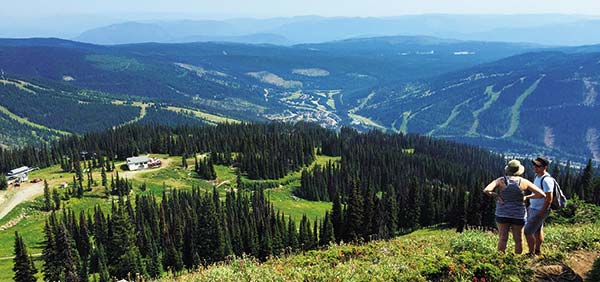
hikers at Sun Peaks Resort
Sun Peaks is 35 miles (56 km) from the city, less than an hour’s drive, and offers summertime relief from Kamloops’s heat with plenty of outdoor activities. In winter, it’s B.C.’s second-largest ski and snowboard resort after Whistler-Blackcomb.
At the base of the mountain, Sun Peaks has a compact village with several hotels, restaurants, and shops. Compared to a large resort like Whistler, the village here is tiny, although it has everything you need for a mountain getaway.
In summer, you can take the Sunburst Express Chair (www.sunpeaksresort.com, 10am-5pm daily late June-early Sept., adults $21, seniors and ages 13-18 $18, ages 6-12 $12) up to an elevation of 6,000 feet (1,850 m) to access a 22-mile (35-km) network of easy and intermediate hiking trails. Colorful wildflowers carpet the slopes, usually peaking in late July or early August.
If you’d rather not hike alone, or if you’d like to learn more about area flora and fauna while you walk, book a two-hour guided alpine nature hiking tour (10am and 1pm Thurs.-Sun. late June-early Sept., $27 pp).
Mountain bikers can tackle more than 35 lift-accessed trails in the Sun Peaks Bike Park (www.sunpeaksresort.com, 10am-5pm daily late June-early Sept., half-day adults $38, seniors and ages 13-18 $32, ages 6-12 $22, full-day adults $47, seniors and ages 13-18 $40, ages 6-12 $28).
Sun Peaks also has a network of cross-country bicycle trails, ranging from beginner to advanced, many of which you can access without purchasing a lift ticket. Get a trail map online to plan your routes. If you’re new to mountain or cross-country biking, consider an introduction to cross-country mountain biking package (10am and 1pm daily late June-early Sept., $106.50 pp) that includes a bike rental, lift ticket, and two-hour lesson. Or book a guided cross-country alpine tour (10am and 1pm daily late June-early Sept., $31.50 pp) for an introduction to the mountain’s trail network.
Elevation Bike Ski Board (Sun Peaks Grand Hotel, 250/578-5555, www.sunpeaksresort.com, 9am-8pm daily late June-early Sept.) rents bikes and related gear for downhill cycling (half-day $56-112, full-day $70-140) and cross-country cycling (1 hour $15-25, half-day $44-88, full-day $20-110).
Imagine whizzing down the mountain in a grown-up go-kart. If that sounds like your thing, try out Sun Peaks’ mountain cross carts (www.sunpeaksresort.com, 11am-8pm daily late June-early Sept., 11am-8pm Fri.-Sun. early-late June and early-late Sept., $25 pp). After you and your cart ride up a platter lift, you drive your vehicle back down a winding 1,680-foot (512-m) course, at speeds up to 35 mph (56 km/h). If that doesn’t sound fast, remember you’re in a go-kart. Your ticket lets you do four laps of the course; you must have a valid driver’s license.
Another way to tour the village and nearby trails is on a Segway. Alpine Explorers (3240 Village Way, 250/851-1905, www.alpine-explorers.com) offers off-road Segway tours (daily mid-May-Sept.) on a big-wheeled model of these self-balancing electric scooters. Among the tour options are a one-hour introductory experience ($60 pp), longer 1.5-hour ($75 pp) and two-hour adventures ($95 pp), and a three-hour tour that takes you out to McGillivray Lake ($150 pp). The minimum age is 14.
On Heffley Lake, off Tod Mountain Road on the way to Sun Peaks Resort, Paddle Surfit (2388 Heffley Lake Rd., Heffley Creek, 250/318-0722, www.paddlesurfit.com, 2 hours $50) rents stand-up paddleboards. The two-hour rentals include a lesson as well as all the paddling gear. Call or check the website for hours.
Northwest Voyageur Canoe Tours (250/578-5268, www.voyageurbistro.ca, daily late-May-Sept.), under the same ownership as the Voyageur Bistro, offers guided paddles on McGillivray Lake in a 30-foot (9-m) replica voyageur canoe, similar to the boats used by Canada’s early fur traders and explorers. Your guide will tell you about local history and point out wildlife along the way.
The standard tour is 90 minutes (adults $45, ages 10-16 $27.95, ages 6-9 $16.75). An entertaining add-on is a multi-course “fur trader’s feast” (lunch $25 pp, dinner $45 pp), a traditional picnic served lakeside.
Make tour reservations at least 72 hours in advance. Because you need at least six people to paddle these substantial canoes, staff will try to match smaller parties with other groups.
With a skiable area of 4,270 acres (1,728 ha) spread across three mountains, Sun Peaks Resort is the second-largest winter sports resort in Canada (www.sunpeaksresort.com, lift tickets adults $105, seniors and ages 13-18 $84, university students $95, ages 6-12 $53). The ski and snowboard season runs late November-early April. Thirteen lifts serve 137 trails, rated 10 percent novice, 58 percent intermediate, and 32 percent expert.
The Voyageur Bistro (Kookaburra Lodge, 3270 Village Way, 250/578-5268, www.voyageurbistro.ca, 4pm-9pm daily, $14-38) injects some Canadiana into its pub-fare-and-more menu. The soup of the day comes with bannock (a traditional aboriginal fried bread), the burger is made with bison, and the mains include venison with cranberry chutney and tourtière (French Canadian meat pie). There’s poutine, too, of course. Frequent live music adds Canadian beats.
Specializing in both savory and sweet crepes, like spinach and feta or strawberries with Nutella, Tod Mountain Café (3170 Creekside Way, 250/571-0545, call for seasonal hours, $4-10) also serves breakfast all day, sandwiches, and smoothies.
Tiny Bolacco Café (Coast Sundance Lodge, 3160 Creekside Way, 250/578-7588, 8am-5pm daily, $4-7) squeezes a lot of good cheer, as well as espresso and fresh-baked pastries, into its pint-size space. Try the berry scones.
Bluebird Market (3250 Village Way, 250/578-2414, 9am-7pm daily) sells basic groceries, snacks, and essentials. Otherwise, the nearest full-service supermarket is in Kamloops, so stock up in advance if you want to prepare your own meals.
Most Sun Peaks accommodations are “ski-in, ski-out,” or within walking distance of mountain activities. Sun Peaks Resort Central Reservations (250/578-5399, www.sunpeaksresort.com) assists with lodging bookings at the several slope-side hotels and nearby condo buildings. Summer rates are much lower than winter season prices.
Close to the lifts, the large Sun Peaks Grand Hotel and Conference Centre (3240 Village Way, 250/578-6080 or 844/774-7263, www.sunpeaksgrand.com, $159-315, parking $15-20) has an upscale dark-wood lobby and 221 contemporary guest rooms. An outdoor heated pool and three outdoor hot tubs can soak away any adventure-induced aches and pains.
Another handy-to-the-lifts option with two outdoor hot tubs, the condo-style Hearthstone Lodge (3170 Creekside Way, 250/578-6969 or 800/811-4588, www.hearthstoneresorthotel.com, $169-255, parking $10-15) has 70 functionally furnished studios and loft studios. Efficiency kitchens come with a full-sized fridge, dishwasher, and cooktop.
Built by Canadian ski racer Nancy Greene, who won a gold medal in the 1968 Winter Olympics, Nancy Greene’s Cahilty Hotel & Suites (3220 Village Way, 250/578-6969, www.cahiltyhotel.com, $135-304, parking $12) has 150 individually owned units, ranging from compact standard rooms with two queen beds, to two-level loft units, to studios and one- and two-bedroom suites. Many, but not all, have kitchen facilities. Greene and her husband, who live at the hotel, regularly greet guests at Sunday evening receptions.
Contact Sun Peaks Resort (1280 Alpine Rd., Sun Peaks, 250/578-5474, www.sunpeaksresort.com) for information about the mountain and various activities. For winter conditions, call the Snow Report (250/578-7232).
Tastefull Excursions (250/312-0707 or 844/314-4555, www.tastefullexcursions.ca, one-way adults $50, ages 6-12 $30) runs 50-minute shuttles between Kamloops Airport and Sun Peaks Resort several times a day year-round. Reservations are required at least 72 hours in advance.
To get to Sun Peaks for a day of skiing, you can take the Mostly Mental Snow Shuttle (250/828-2558, www.sunpeaksresort.com, daily Dec.-Mar., one-way $20). The shuttle picks up passengers from locations in Kamloops and takes you to the mountain in the morning, then returns you to town in the afternoon.
Mount Revelstoke National Park’s main attraction is a great drive: the zigzagging Meadows in the Sky Parkway that climbs steeply to an elevation of more than 6,500 feet (2,000 m). From the top of the parkway, you can walk up the only mountain in Canada’s national park system that you can summit by hiking just a short distance from your car. And lest you think that this snaking road to the summit is a modern innovation, the parkway was constructed between 1911 and 1927. Work on the road actually began before the region became a national park in 1914.
Located in the Selkirk range of B.C.’s Columbia Mountains, Mount Revelstoke National Park has longer hikes, too, including a number of great day hikes from the Meadows in the Sky summit. Another highlight at the summit area are the summer wildflowers that carpet the slopes with color, peaking in early-mid August.
The visitor season is short here, however; the parkway summit is typically open only July-September. The rest of the year, it’s too snow-covered to travel.
Driving from the west along the Trans-Canada Highway (Hwy. 1), the turnoff for Revelstoke, the town closest to the park, is just before you get to the exit for the Meadows in the Sky Parkway. From the east, Highway 1 skirts, and in some cases crosses, the park’s southern boundary after passing through Glacier National Park.
You can camp in Mount Revelstoke National Park. Nearby Revelstoke has accommodations, restaurants, and other services.
The main entrance to Mount Revelstoke National Park is at the base of the Meadows in the Sky Parkway, off Highway 1 near Revelstoke. Highway 1 runs through parts of the park, and some hiking trails begin just off the highway.
A day pass (adults $7.80, seniors $6.80, families $15.70) for Mount Revelstoke National Park is valid until 4pm on the day after you purchase it. You can buy a park pass at the entrance to the Meadows in the Sky Parkway.
Purchasing a Parks Canada annual discovery pass (adults $67.70, seniors $57.90, families $136.40), which is valid for a year, is a good deal if you’re spending at least a week in one or more parks. It’s accepted at more than 100 national parks and national historic sites across Canada. You can buy an annual pass online from Parks Canada (www.pc.gc.ca) or at any park visitors center.
For both day and annual passes, family passes cover up to seven people arriving together in a single vehicle, whether or not they’re actually related.
Park information is available in Revelstoke at the Revelstoke Visitor Information Centre (301 Victoria Rd. W., 250/837-5345 or 800/487-1493, www.seerevelstoke.com, 8:30am-7pm daily July-Aug., 8:30am-4:30pm daily Sept.-June) or the Parks Canada information office (301B 3rd St. W., 250/837-7500, www.pc.gc.ca, 8am-noon and 1pm-4:30pm Mon.-Fri.).
While Mount Revelstoke National Park is located just outside the town of Revelstoke, there are no public transportation options or shuttle services that operate to or within the park. You need a car to get around.
The park’s 16-mile (26-km) Meadows in the Sky Parkway climbs steeply from an elevation of 1,315 feet (400 m) to over 6,500 feet (2,000 m). As the road rises and twists around the 16 switchbacks, snaking its way up the mountain, you can stop at several viewpoints; the Revelstoke Viewpoint looks down on the town in the valley below, while other lookouts offer vistas across the mountains.

rest stop along the Meadows in the Sky Parkway
It’s not just about the drive, though. Once you reach the end of the parkway, you can access a number of hiking trails, ranging from easy to challenging.
You’ll need to leave your car at the Balsam Lake parking lot, since the road is not open to private cars all the way to the mountain summit. From the parking area, it’s a 0.6-mile (1-km) walk to the summit, either on the Upper Summit Trail, a gently climbing, wooded, dirt and gravel path, or along the road. Alternatively, take the free summit shuttle bus (10am-5:30pm daily July-early Sept., 10am-4:30pm early Sept.-early Oct., weather permitting), which runs every 15-20 minutes, up to the Heather Lake summit area. If you’re heading up late in the day, confirm the time that the last shuttle returns. Before or after your time at the summit, take a few minutes to walk around tiny Balsam Lake.
Allow about three hours for your Meadows in the Sky excursion. It takes 35-45 minutes to drive each way, plus time to get from the parking lot to the summit area. Plan at least an hour to hike and enjoy the views at the summit; you could easily spend an entire day if you’d like to do one of the longer hikes.
The parkway is generally open May-October, but snow can remain at higher elevations until July or August, which means that the summit area is typically accessible only between mid-late July and late September. Confirm road conditions and open hours with park staff before you set out.
The Meadows in the Sky Parkway Entrance Station (8am-5pm daily mid-June-early Sept., 9am-5pm daily mid-May-mid-June and early Sept.-early Oct.) is 0.5 mile (0.8 km) northeast of Revelstoke off Highway 1.
The parkway closes to uphill drivers at 5:30pm, but you can return downhill until 8:30pm mid-June-early September, until 6:30pm mid-May-mid-June and September, and until 5:30pm in October.
Bring water and whatever food you might need; there are restrooms but no other services along the Meadows in the Sky Parkway and at the summit area. Bring extra layers of clothing, too, since it’s always cooler up on the mountain than it is in town.
Mount Revelstoke National Park has several trails from the summit area of the Meadows in the Sky Parkway. Other trails are off the parkway at lower elevations, and additional trails are to the east, off Highway 1.
You get panoramic views across the mountains and down to the Columbia River from the Firetower Trail, a gentle 0.3-mile (480-m) climb to the 1927 Summit Firetower, a cabin with a cupola-style lookout on top. Park firefighters used the tower as a lookout until 1987, when satellite fire monitoring and aerial fire patrols replaced the human guards.
Another easy trail is the First Footsteps Trail, a 0.5-mile (0.8-km) loop, which has First Nations art, interpretive panels, and viewpoints along the way. You can also follow the 10-minute Heather Lake Trail around the subalpine lake of the same name.
If you have more time, an excellent intermediate-level hike follows the Eva Lake Trail through wildflower meadows and boulder fields to a beautiful alpine lake, which is named for Eva Hobbs, a Revelstoke teacher and avid hiker who discovered the lake on a 1909 outing with the Revelstoke Mountaineering Club. The trail is 8.5 miles (14 km) round-trip. Along the way, you have the option to make a short detour to Miller Lake.
A more difficult hike climbs the Jade Lakes Trail (11 mi/18 km round-trip), crossing Jade Lake Pass into the alpine regions above the tree line. The Eva Lake, Miller Lake, and Jade Lakes Trails all start from the same point but divide along the way.
Nels Nelson (1894-1943) emigrated from his native Norway to Revelstoke, where he became known for his ski jumping prowess, making several record-setting jumps in the 1920s. You can follow in his footsteps—or stand in his (virtual) skis—with a hike on the Nels’ Knickers Trail. At the trail’s summit, you can lean into his “knickers,” a metal sculpture outlining Nelson’s body, crouched as if to jump, on a platform cantilevered out above the hill. It’s a fun photo op. The easiest way to reach the Nels’ Knickers platform is from the upper trailhead off the Meadows in the Sky Parkway at 0.8 mile (1.4 km); from there, you can follow a flat path for a 5- to 10-minute walk to the sculpture. Alternatively, you can park in the Nels Nelsen parking lot and hike up the short (less than 0.5 mi/0.8 km) but steep trail to the platform.
As you travel Highway 1 between Revelstoke and Glacier National Park, you can stop off for several easy walks that illustrate different ecosystems within Mount Revelstoke National Park.
Have you ever seen a giant skunk cabbage? They look like, well, gigantic cabbages, and you can see them as you wander across the marshes and wetlands along the Skunk Cabbage Boardwalk Trail, an easy 0.75-mile (1.2-km) loop. If you visit in May when their yellow flowers bloom, you’ll understand the “skunk” component of the name. The trail is 17 miles (27 km) east of Revelstoke, off Highway 1.
You typically find temperate rainforest climates along the British Columbia coast and in other coastal regions. B.C.’s Columbia Mountains, including sections of Mount Revelstoke National Park, house the world’s only inland temperate rainforest, including plentiful old-growth forests where western red cedar and western hemlock predominate. Explore this old-growth forest on the Giant Cedars Boardwalk Trail, a 0.3-mile (480-m) boardwalk that loops past massive cedars, some of which are more than 500 years old. The trail starts 19 miles (30 km) east of Revelstoke.
A 50-site campground, accommodating tents and RVs, is slated to open in 2019 near the entry kiosk along the Meadows in the Sky Parkway at the base of Mount Revelstoke. Check the park website for updates and rates.
Transportation, forestry, and tourism drive the economy of Revelstoke, a community of 7,500 in B.C.’s Selkirk and Monashee Mountains. Located on the Columbia River outside Mount Revelstoke National Park, the town is an outdoor-oriented place, drawing hikers and cyclists in summer, and skiers and snowboarders during the colder months. Revelstoke Mountain Resort is famous for its powder skiing; the area gets 40-60 feet (12-18 m) of snow in a typical winter season.
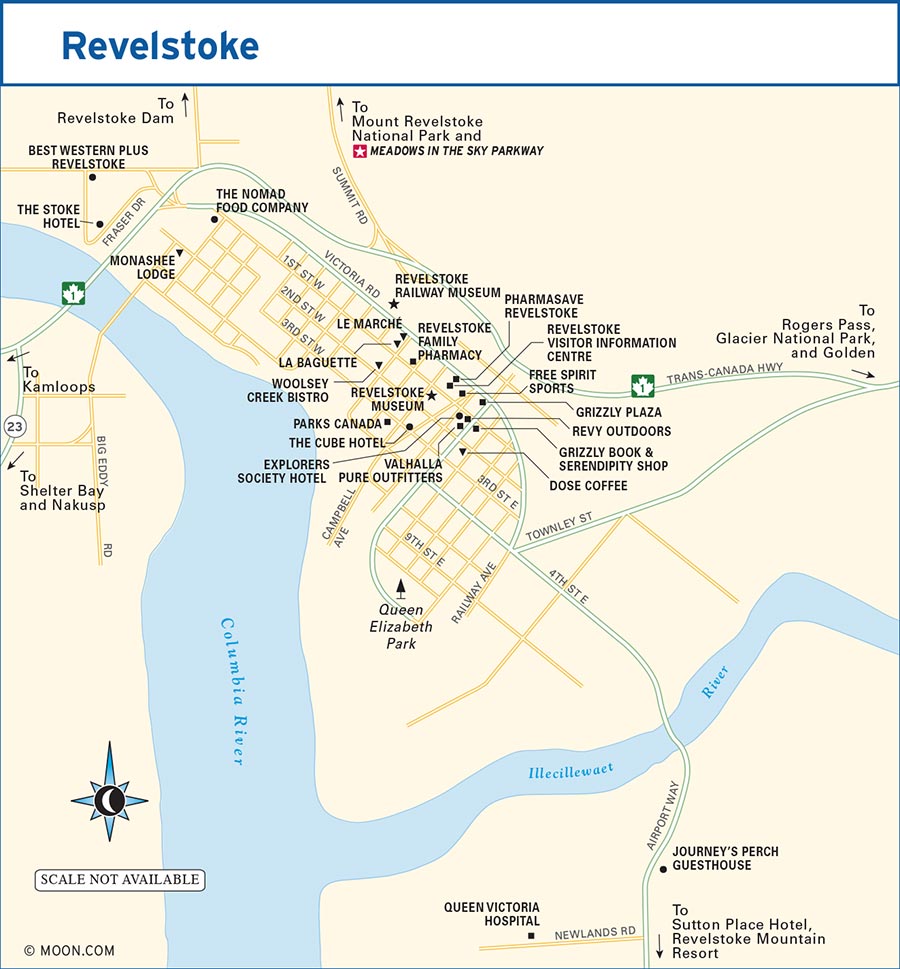
Located in the town’s former post office, the Revelstoke Museum (315 1st St. W., 250/837-3067, www.revelstokemuseum.ca, 10am-5pm Mon.-Sat., 11am-5pm Sun., adults $5, seniors $4, ages 13-18 $2, families $12) helps answer the question, “Why is Revelstoke here?” It’s because of the railroad that the modern-day town developed, beginning in the 1880s as a construction base for workers building the transcontinental railroad. When the trains began to run—10 passenger trains every day once passed through town—the Canadian Pacific Railway was the region’s major employer, drawing workers from across Canada and from China, Italy, and Scandinavia. Those Scandinavian settlers helped introduce Revelstoke to the sport that dominates today’s tourism economy: skiing.
To learn more about Revelstoke’s railroad history, including how the railroad was built and the people who built it, visit the Revelstoke Railway Museum (719 Track St. W., 250/837-6060, www.railwaymuseum.com, 9am-5pm daily May-mid-Oct., adults $10, seniors $8, ages 8-17 $5, ages 4-7 $2, families $22). Inside you can climb aboard a steam locomotive or imagine traveling in high style in the 1929 “Business Car No. 4,” where the white tablecloths are set for dinner. Practice your skills as an engineer on the diesel locomotive simulator, or explore the stories of the Chinese railroad workers. Outside are more historic rail cars, including a coal car, a snowplow, and a caboose. You don’t have to be a train buff to enjoy this well-designed museum.
North America’s fourth-largest river, the Columbia, starts in British Columbia and flows through Washington and Oregon to the Pacific Ocean. The massive Revelstoke Dam, completed in 1984 after eight years of construction, harnesses the Columbia to produce electricity, generating 25 percent of B.C.’s power. At the Revelstoke Dam Visitor Centre (Hwy. 23, 250/814-6697 or 800/224-9376, http://bchydro.com/revelstoke, 10am-4pm daily mid-May-early Sept., adults $6, seniors and ages 6-17 $5, families $15), 3 miles (5 km) north of Revelstoke via Highway 23, you can learn about the dam’s construction and operation; take the elevator up to a viewing area at the top of the dam 30 stories above the river. B.C. Hydro, the provincial electric company, runs the visitors center, so the exhibits have an industry perspective, but they’re still interesting if you’re curious about rivers, dams, and power generation.
For a short hike in town, follow the paved Revelstoke Greenbelt Trails. One route starts in Centennial Park, behind the Revelstoke Community Centre (600 Campbell Ave.), and meanders east along the Columbia and Illecillewaet Rivers. Another option is the Revelstoke Dyke Walk; cross the Big Eddy Bridge from Wilson Avenue at the west end of town and turn left onto the dyke.
Unlike many ski mountains with a large purpose-built village at the base, Revelstoke Mountain Resort (2950 Camozzi Rd., 250/814-0087 or 866/373-4754, www.revelstokemountainresort.com), a 10-minute drive from the center of Revelstoke, has only a hotel, a few food outlets, and a couple of shops. Many visitors who come to ski or snowboard in winter or to hike and bike in summer come to the mountain to get outdoors and return to town to eat and sleep. Yet there’s plenty to do at this 3,121-acre (1,263-ha) mountain resort, which, at 5,620 feet (1,713 m), has North America’s greatest vertical drop.
Although Revelstoke’s peak season is winter, the resort offers some summer activities, too, including a network of lift-accessed hiking trails, ranging from beginner-friendly to expert-only routes. Most trails start at the top of the upper gondola (8:30am-5pm late June-early Sept., adults $30, ages 6-12 $15).
You can take the lower gondola partway up the mountain for a buffet breakfast at the Revelation Lodge (8am-11am Mon.-Fri., 8am-1pm Sat.-Sun. mid-May-early Sept., 8am-11am daily early Sept.-mid-Oct., gondola access plus buffet breakfast adults $40, ages 6-12 $20), where your bacon and eggs come with views across the valley. The vistas are even better from the patio tables. If you’re feeling energetic, hike back down to the base after your meal.
Another option for summertime fun is a ride on the pipe mountain coaster (8am-8pm daily late June-early Sept., 9am-5pm daily mid-May-late June and early Sept.-mid-Oct., ages 8 and over $25 per ride), which whizzes 0.9 mile (1.4 km) through the forest between the Revelation Lodge and the mountain base.
Summer lift tickets are discounted if you buy them online in advance, and reduced-rate packages combining mountain activities are also available.
Revelstoke Mountain is open for skiing and snowboarding (www.revelstokemountainresort.com, adults $109, seniors and ages 13-18 $89, ages 6-12 $44) late November or early December-mid-April. The mountain’s ski and snowboard terrain leans heavily toward the expert and intermediate categories. Only 7 percent of the 69 runs are classified as “beginner.” Lift ticket prices vary with the season and the number of days purchased; you can usually save money buying your tickets online in advance.
Other winter activities include snowshoe tours (1.5-2.5 hours, adults $40-60, ages 11-16 $25-50, ages 8-10 free) and dog-sled tours (3 hours, $199 single, $279 double). Book online or through the resort’s activity center.
Every evening in late June-end of August, head downtown for free live music (6:30pm-9:30pm), outdoors at Grizzly Plaza (Mackenzie Ave. at Victoria Rd.), with bands from across the region.
If you need clothing or gear for your outdoor adventures, look in downtown Revelstoke, where sport shops include Free Spirit Sports (203 1st St. W., 250/837-9453, www.freespiritsports.com, 9:30am-6pm Mon.-Thurs. and Sat., 9:30am-10pm Fri.), Revy Outdoors (201 Mackenzie Ave., 250/814-2575, 10am-6pm Mon.-Sat., 11am-5pm Sun.), and Valhalla Pure Revelstoke (213 Mackenzie Ave., 250/837-5517, www.vpo.ca, 9:30am-7pm Mon.-Sat., 10:30am-6pm Sun.).
You don’t know what treasures you might find at the Grizzly Book and Serendipity Shop (208 Mackenzie Ave., 250/837-6185, www.grizzlybook.com, 9:30am-5:30pm Mon.-Sat.), part independent bookstore and part jewelry and gift shop. It’s been supplying Revelstoke with things to read since 1989.
A sunny yellow house is home to the accomplished S Woolsey Creek Bistro (604 2nd St. W., 250/837-5500, www.woolseycreekbistro.ca, 5pm-9pm daily, $21-26), where you can enjoy world-rambling creations in a spacious casual dining room or on the outdoor patio. The simple house salad of greens and goat cheese is first-rate, while mains might range from confit duck leg with calendula risotto, to grilled salmon paired with cilantro-mint harissa and a grilled vegetable salad, to short ribs braised in local beer. Save room for a dessert like the dark-chocolate truffle cake or a fresh fruit sorbet.
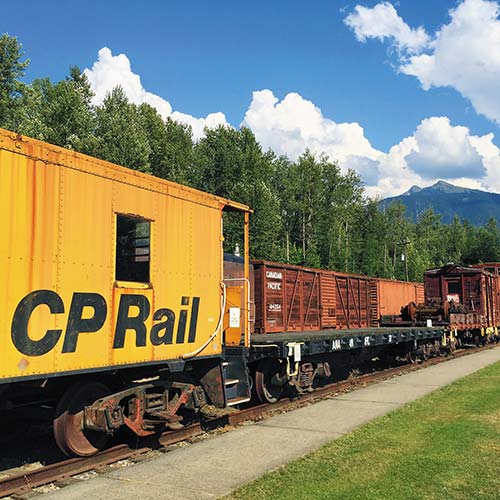
historic rail cars at the Revelstoke Railway Museum
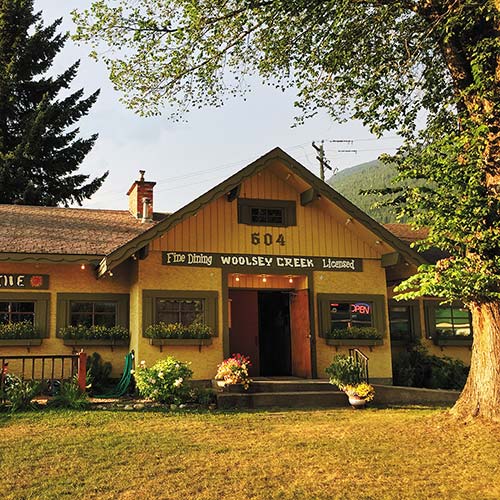
Woolsey Creek Bistro
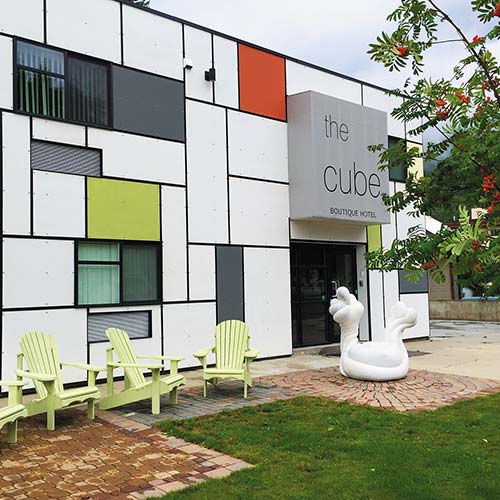
The Cube Hotel
You’d expect that an eatery named S La Baguette (607 Victoria Rd., Unit 103, 250/837-3755, 6:30am-5pm daily, $5-16) would make excellent breads and pastries, and you’d be right; the shop even bakes its own bagels. But this popular café doesn’t stop there. First-rate coffee plus a changing assortment of sandwiches, pizzas, and pastas round out the menu. The same owners run Le Marché (607 Victoria Rd., Unit 101, 9am-8pm daily), a gourmet grocery around the corner, where you can pick up charcuterie, well-priced cheeses, organic produce, and some prepared foods—perfect for picnicking in the national parks.
Pull up a chair under the street art-style wall mural and stay awhile at Dose Coffee (101 2nd St. E., 250/837-6215, www.dosecoffee.ca, 6:30am-5pm daily, $7-12). This hip Revelstoke hangout can kick-start your morning with well-made espresso drinks, smoothie bowls, and breakfast sandwiches, or refresh you with soups, salads, and baked goods all day.
Nomads and locals alike stop into The Nomad Food Company (1601 Victoria St. W., 250/837-4211, 11am-9pm daily summer, 11am-8pm daily winter, $7-15) for cooked-to-order burgers, paninis, poutine, and other diner-style fare. With a few tables inside and picnic tables out in the parking lot, it’s nothing fancy, but everything is hearty, fresh, and moderately priced.
Revelstoke has several chain motels along Highway 1, but it’s much nicer to get off the highway and into town.
Located downtown, S The Cube Hotel (311 Campbell Ave., 250/837-4086, www.cubehotel.ca, $72-140) pairs the relaxed vibe of a simple guesthouse with the style of a modern boutique hotel. Guests can hang out in the cool communal lounge space with lime-green walls and overstuffed couches, where a complimentary continental breakfast is served. You can prep meals in the shared kitchen. The 21 no-frills guest rooms provide a space to sleep, plus essentials like free Wi-Fi, flat-screen TVs, sinks, and toilets; seven individual shower rooms are down the hall.
An updated roadside motel on the west end of town, The Stoke Hotel (1911 Fraser Dr., 250/837-5221 or 877/837-5221, www.stokehotel.ca, $99-149) has simple rooms with a dose of quirky style. Outfitted with a mix of old wooden cabinets and newer pieces, like bright blue metal chairs, rooms all have interesting wall art, plus coffeemakers, microwaves, and mini fridges. Red plaid pillows and other Canadiana decorate the lobby, and you can head upstairs to the diner-style breakfast room for a basic continental spread.
Located in a former church, Journey’s Perch Guesthouse (1502 Mountain View Dr., 250/683-8708, www.journeysperch.com, $45-53 dorms, $110-135 d) is friendly place to rest, with a contemporary hostel vibe. The three comfortable private rooms and the four-bed dorms share three modern baths. There’s plenty of common space, from a communal kitchen to a sitting room with original stained-glass windows. Rates include continental breakfast, Wi-Fi, and free passes to the local aquatic center.
It may be hard to get back on the road once you’ve settled into the rooftop hot tub at the S Explorers Society Hotel (111 1st St. W., 250/814-2565 or 855/814-2565, www.explorers-society.com, $199-259), a design-conscious boutique lodging in a 1911 heritage building downtown. The nine guest rooms—six standard units and three larger suites with sitting areas—mix historical features, like original brick walls, with geometric-patterned black-and-gray throws, exposed concrete, and other chic contemporary elements. French press coffee pots, minibars stocked with local craft beer and cider, Internet-connected TVs, and Wi-Fi are among the amenities. Staff set up a self-serve breakfast in the top-floor lounge with its mid-century modern furnishings and mountain-view terrace. The lobby-level Quartermaster Eatery takes you between North and South America with dishes like Peruvian-style chicken with smashed yams, mesquite-grilled wild salmon, and grass-fed steaks. Vegans (or veggie-lovers) should consider the house-made morel sausages paired with roasted vegetables.
In the contemporary condo-style Sutton Place Hotel Revelstoke Mountain Resort (2950 Camozzi Rd., 250/814-5000 or 866/378-8866, www.suttonplace.com/revelstoke, $130-522 d, 2-bedroom suite $225-802, 3-bedroom suite $297-942), at the base of Revelstoke Mountain Resort, 205 suites, ranging from studios to three-bedroom units, all have fireplaces, fully equipped kitchens, and washer-dryers. Other amenities include an outdoor heated pool and hot tub, a spacious fitness room, a spa, and underground parking. In winter, you’re steps from the lifts; in summer, you can go exploring with one of the complimentary mountain bikes.
Staff at the Revelstoke Visitor Information Centre (301 Victoria Rd. W., 250/837-5345 or 800/487-1493, www.seerevelstoke.com, 8:30am-7pm daily July-Aug., 8:30am-4:30pm daily Sept.-June) can assist with information about the Revelstoke region and other destinations across the province. If you’re interested in hiking, staff can advise you about area trails and provide a hiking map. Pick up the free Tourism Revelstoke guide to the area here; it’s also available online.
Parks Canada maintains a year-round information office (301B 3rd St. W., 250/837-7500, www.pc.gc.ca, 8am-noon and 1pm-4:30pm Mon.-Fri.) in the city’s post office building.
The emergency room at Revelstoke’s Queen Victoria Hospital (1200 Newlands Rd., 250/837-2131, www.interiorhealth.ca) is open 24 hours daily, seven days a week. Local pharmacies include Pharmasave Revelstoke (307 W. Victoria Rd., 250/837-2028, www.pharmasaverevelstoke.com, 9am-8pm Mon.-Thurs., 9am-9pm Fri., 9am-6pm Sat., 11am-5pm Sun.) and Revelstoke Family Pharmacy (555 Victoria Rd., 250/837-5191, www.pharmachoice.com, 9am-6pm Mon.-Sat., 11am-4pm Sun.).
Revelstoke’s downtown area is compact and walkable. The community has limited bus service, run by B.C. Transit (250/837-3888, http://bctransit.com/revelstoke, 8am-6pm Mon.-Sat., adults $2, seniors and ages 5-17 $1.75). To explore the national parks outside town, you need a car.
When Revelstoke Mountain Resort is open for skiing and riding in winter, Everything Revelstoke Resort Express (250/837-5044, www.everythingrevelstoke.com, one-way $4) runs frequent shuttles between downtown and the mountain.
As you might guess from its name, Glacier National Park is known for the broad glaciers and jagged mountains that populate its 333,000-acre (135,000-ha) expanse. Established in 1886 along with Yoho National Park, not long after the completion of Canada’s transcontinental railroad, it was British Columbia’s first national park and the second national park in Canada, after Banff. It is not connected to the U.S. national park of the same name.
Most early visitors to Glacier National Park came by rail, after the transcontinental railroad opened the region to tourism. It wasn’t until 1962 when the Rogers Pass section of the Trans-Canada Highway, which runs east-west across the park, was completed and visitors began road-tripping in and around the park.
A number of sights and short hiking trails are just off the Trans-Canada (Hwy. 1). If you’re short on time, go directly to the Rogers Pass Discovery Centre, which has well-designed exhibits about the park and the surrounding areas.
The best months to visit Glacier National Park are July-early September. Much of the park’s terrain is at high mountain elevations, and the region gets heavy snow during the winter months. While the park is technically open year-round, the weather makes many areas inaccessible between October and May. Park staff advise contacting them before visiting in spring (Apr.-June) or fall (Sept.-Oct.) for an update on road conditions and to confirm what’s open.
TIP: Fill your gas tank in Revelstoke or Golden. There are no gas stations or other services between these two towns or anywhere in Glacier National Park.
The Trans-Canada Highway (Hwy. 1) runs through Glacier National Park. Glacier’s western boundary is 10 miles (16 km) east of Mount Revelstoke National Park. The east entrance is 35 miles (56 km) west of Golden.
There is no entrance gate when you approach Glacier National Park from the west, so purchase your park pass at the Revelstoke Visitor Information Centre. Similarly, if you’re coming from the east, you can buy a park pass at the Golden Visitor Centre. If your first stop in Glacier National Park will be the visitors center at Rogers Pass, purchase your pass there.
A day pass (adults $7.80, seniors $6.80, families $19.60) for Glacier National Park is valid until 4pm on the day after you purchase it.
Buying a Parks Canada annual discovery pass (adults $67.70, seniors $57.90, families $136.40), which is valid for a year, is a good deal if you’re spending at least a week in one or more parks. It’s valid at more than 100 national parks and national historic sites across Canada. Buy your annual pass online from Parks Canada (www.pc.gc.ca) or at any park visitors center.
For both day and annual passes, the family passes cover up to seven people in a single vehicle, whether or not they’re actually related.
If you’re driving through the park along Highway 1 without stopping, a park pass isn’t required. However, you need a pass if you get out of your car anywhere within the park boundaries.
The Rogers Pass Discovery Centre, which houses the Glacier National Park Visitor Centre (Hwy. 1, 250/837-7500, www.pc.gc.ca, 8am-7pm daily mid-June-early Sept., 9am-5pm daily May-mid-June and early Sept.-mid Nov., 7am-4pm daily mid-Nov.-Apr.), is at the Rogers Pass summit, 45 miles (72 km) east of Revelstoke and 50 miles (80 km) west of Golden.
Glacier National Park’s campgrounds are first-come, first-served; reservations are not possible.
There are no public transportation options or shuttle services that operate in Glacier National Park, so you need to have a car to get around.
The coast-to-coast Trans-Canada Highway is the longest highway in the world, running 4,849 miles (7,821 km) from Victoria, on British Columbia’s Vancouver Island, to St. John’s, Newfoundland. It was officially completed at Rogers Pass, in Glacier National Park, which helped open the region for tourism. Canadian prime minister John Diefenbaker led the opening ceremony at the pass in 1962.
You can learn more about the highway’s history and construction, as well as the area’s wildlife and weather, with the informative exhibits at the Rogers Pass Discovery Centre (Hwy. 1, 250/837-7500, www.pc.gc.ca, 8am-7pm daily mid-June-early Sept., 9am-5pm daily May-mid-June and early Sept.-mid-Nov., 7am-4pm daily mid-Nov.-Apr.), which is also the park’s visitors center.
At an elevation of 4,364 feet (1,330 m), Rogers Pass is the third-highest point on the Trans-Canada Highway, and the pass is all too frequently closed in winter due to heavy snow or avalanche danger. If you have time, watch the film The Snow Wars, about managing avalanche risks. Although the film was made in the late 1970s, and communications technology (and hairstyles) have advanced, technicians still use the same processes for testing the snow quality to predict avalanche risk and use blasts of the same military howitzers to trigger controlled avalanches around the region. You can see those howitzers on display in front of the Discovery Centre as well.
The Rogers Pass Discovery Centre is at the Rogers Pass summit, 45 miles (72 km) east of Revelstoke and 50 miles (80 km) west of Golden.
Glacier National Park has 87 miles (140 km) of hiking trails. Some park trails are just off Highway 1, but they’re not always well marked. Watch carefully for signs as you approach your stopping point.
Check the Parks Canada Trail Conditions Report (www.pc.gc.ca) online or ask about trail status at the Glacier National Park Visitor Centre before setting out on any long hikes.
The Hemlock Grove Trail is a short 0.2-mile (350-m) boardwalk trail that loops through old-growth cedars and hemlocks. These trees are big! The trail is on the west side of the park, on the north side of Highway 1.
For mountain views, follow the Rock Garden Trail up a series of rock staircases and stepping-stones. A 0.25-mile (400-m) loop, it’s not long, but a few sections can be steep and slippery in wet weather. Like the Hemlock Grove Trail, the trailhead is on the west side of the park, on the north side of Highway 1.
The 0.6-mile (1-km) Bear Creek Falls Trail leads down a short, somewhat steep trail to a pretty waterfall. The turnoff from Highway 1 is sharp and not well marked, so watch carefully for the trailhead sign, 5.5 miles (9 km) east of the park visitors center.
For a longer day hike, the Avalanche Crest Trail, 5 miles (8 km) round-trip, climbs from the trailhead in the Illecillewaet Campground (1.9 mi/3 km west of the Rogers Pass summit) up into an alpine basin, where you have panoramic views over Rogers Pass. This steep trail has an elevation gain of 2,600 feet (800 m). Allow at least five hours for the hike.
The Asulkan Valley Trail takes you to the tongue of the Illecillewaet Glacier. Another steep route, this trail starts gently as it leaves the trailhead in the Illecillewaet Campground, but after the 2.5-mile (4-km) mark, the pitch goes up much more sharply. The trail is 8.6 miles (13.8 km) round-trip, with an elevation gain of 2,850 feet (869 m). Plan 6-7 hours for this hike.
Glacier National Park has three rustic drive-in campgrounds, but no other accommodations or food concessions. The park is close enough to the towns of Revelstoke and Golden that staying in either of these communities is an option.
If you don’t want to camp, the best accommodations near the park are the Heather Mountain Lodge & Cabins (5400 Hwy. 1 W., Golden, 250/344-7490 or 866/344-7490, www.heathermountainlodge.com, mid-June-mid-Sept., $154-257 d, $300 cabin), 1.2 miles (2 km) outside the park’s east gate. The 22 mountain-style guest rooms in a two-story motel block have been updated with light wood furnishings, modern baths, flat-screen TVs, free Wi-Fi, and Nespresso machines. Even nicer, and far more romantic, are the two private log cabins, with king beds, woodstoves, in-floor heating, rain showers, and deep soaker tubs. The lodge is 53 miles (85 km) east of Revelstoke and 33 miles (53 km) west of Golden. December-mid-April, the lodge is reserved for clients booked on heli-skiing trips with its sister company, Great Canadian Heli-Skiing (250/344-2326 or 866/424-4354, http://canadianheli-skiing.com).
Serving creative mountain fare, the Restaurant at Heather Mountain Lodge (8am-10am and 6pm-9pm daily late June-mid-Sept., $24-42) is worth a stop, even if you’re not staying at the lodge. Among the hearty mains, look for mustard-crusted rack of lamb or free-range Alberta beef tenderloin. The dining room, with a high wood-beamed ceiling and a stone fireplace, looks out to the nearby mountains. If you’re making a reservation, note that the lodge is in mountain time zone, the same as Alberta but one hour later than Glacier National Park and the B.C. coast.
Glacier National Park’s three campgrounds, all along Highway 1 near the center of the park, are open only during the summer months. Since reservations aren’t accepted, plan to arrive before noon to make sure you get the site you want.
None of the campgrounds have showers, RV hookups, or laundry facilities. Most sites are designed to accommodate tents or small RVs, so if you’re driving a big rig, you might need to look elsewhere.
The largest camping area, 60-site Illecillewaet Campground (late June-early Oct., $21.50), is 1.9 miles (3 km) west of the Rogers Pass summit. The Loop Brook Campground (July-Sept., $21.50), 3 miles (5 km) west of the summit, has 20 campsites. Both of these campgrounds have restrooms with flush toilets and drinking water.
The park also has a 15-site primitive campground, Mount Sir Donald Campground, with no facilities, 0.6 mile (1 km) west of the Loop Brook Campground. However, due to a spruce beetle infestation, this campground has been temporarily closed; check with the park office for updates.
One of the most centrally located towns in the B.C. Rockies, Golden makes a good base for visiting the region’s national parks. It’s set between Glacier to the west and Yoho to the east; Mount Revelstoke, Kootenay, Lake Louise, and Banff are all within a short drive.
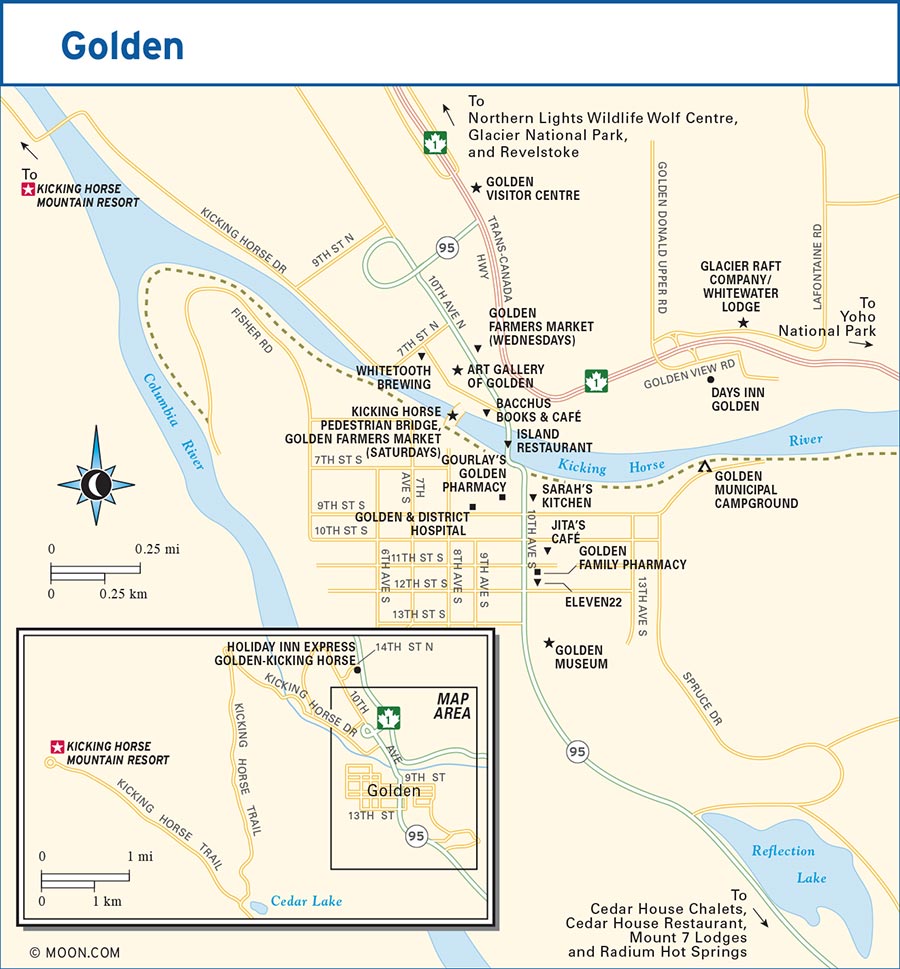
Located at the confluence of the Columbia and Kicking Horse Rivers, the Golden region was an important travel route for indigenous people who lived in the area for millennia. Now its river location makes Golden a center for white-water rafting and river float trips. Just west of town is Kicking Horse Mountain Resort, which offers serious powder skiing in winter and a variety of outdoor experiences during the summer season.
When you’re wandering through this town of 3,700, stop to see the Kicking Horse Pedestrian Bridge (8th Ave. N.), over the Kicking Horse River. You wouldn’t think it’s a record-breaker, but at 151 feet (46 m) across, it’s the longest freestanding timber-frame pedestrian bridge in Canada.
Note that Golden is in the mountain time zone, the same as Alberta and one hour ahead of Vancouver and the B.C. coast.
Golden is a center for white-water rafting, with long stretches of Class III and IV rapids on the Kicking Horse River east of town. Several local outfitters offer half- and full-day white-water rafting trips ($99-269), as well as gentler family-oriented rafting tours ($59-89). Many trips have minimum age requirements, so check ahead if you’re traveling with kids or teens.
Golden’s rafting season typically runs May-September, with the highest river levels and fastest water in June and early July.
Glacier Raft Company (1509 Lafontaine Rd., 250/344-6521 or 877/344-7238, www.glacierraft.com) runs a variety of on-the-water adventures, from an introductory white-water experience to several wet-and-wild rafting trips; guides can even take you heli-rafting. It also offers a laid-back two-hour guided inflatable kayak tour (ages 10 and up $79) that begins on a gentle section of the Kicking Horse River and continues to the point where the Kicking Horse meets the Columbia.
Other Kicking Horse rafting outfitters include Alpine Rafting (101 Golden Donald Upper Rd., 250/344-6778 or 888/599-5299, www.alpinerafting.com), Hydra River Guides (2936 Kicking Horse Rd., 403/762-4554 or 800/644-8888, www.raftbanff.com), and Wild Water Adventures (2750 Beaverfoot Rd., 403/522-2211 or 888/647-6444, http://wildwater.com).
For a close-up look at Canada’s gray wolves, visit Northern Lights Wildlife Wolf Centre (1745 Short Rd., 250/344-6798, www.northernlightswildlife.com, 10am-6pm daily May-June and Sept., 9am-7pm daily July-Aug., noon-5pm daily Oct.-Apr., adults $12, seniors and ages 12-16 $9, ages 4-11 $6, families $35). Housing several gray wolves in outdoor enclosures, this interpretive center offers 25-minute tours, explaining the wolves’ habits, food preferences, and pack structure. Schedule your stop here for the morning, if you can, when the animals are typically most active.
The Wolf Centre is 11 miles (18 km) northwest of Golden, off Highway 1.
The small but well-designed Golden Museum (1302 11th Ave. S., 250/344-5169, www.goldenbcmuseum.com, 10am-5pm Mon.-Fri., donation) tells the stories of the region’s history, from its First Nations and Métis communities to its early explorers, to the importance of the railroad to the region. British explorer David Thompson was the first non-aboriginal person to settle in Golden, when he arrived in 1807 with his Métis wife, Charlotte Small, and their four children as part of a mapping expedition for the Northwest Company. Thompson and Small were married for 55 years and eventually had 14 children, although they remained in the Golden area for just a few years. Later, Golden had one of the earliest Sikh temples in Canada, when many Sikhs moved from the Vancouver region to work in the logging industry.
The Art Gallery of Golden (516 9th Ave. N., 250/344-6186, www.kickinghorseculture.ca, 10:30am-5:30pm Mon.-Sat., 11am-4pm Sun. July-Aug., 10:30am-5:30pm Mon.-Sat. Sept.-June) is part gallery and part craft boutique, showing and selling works by regional artists.
Golden’s first craft brewery, Whitetooth Brewing (623 8th Ave. N., 250/344-2838, www.whitetoothbrewing.com, 2pm-10pm daily) has a huge, sunny patio, where you can while away the afternoon with a beer or two, like the Whitetooth Session (a blond ale), the Belgian-style Icefields pale ale, or the malty Directissima Dubbel.
In June, July, and August, Kicking Horse Culture (250/344-6186, www.kickinghorseculture.ca) organizes the Summer Kicks series of concerts and other arts events. Check the website or call for the schedule and details.
In a log house on the river, Island Restaurant (101 10th Ave., 250/344-2400, www.islandrestaurant.ca, 9am-9pm daily, breakfast $9-17, lunch and dinner $15-33) serves a crowd-pleasing “Canadian mountain fusion” menu that includes sandwiches and salads, house-made pastas, and hearty plates like buffalo in mushroom-brandy sauce. Island is open for breakfast as well. On a warm day, ask for a patio table.
Cedar House Restaurant (735 Hefti Rd., 250/344-4679, www.cedarhousechalets.com, 5pm-10pm daily July-Aug., 5pm-10pm Wed.-Sun. Sept.-June, $28-37) serves contemporary Canadian fare using lots of local organic ingredients. After sipping a glass of B.C. wine or local craft beer, you might sup on a duck confit tart, arctic char in a lemon-ginger cream sauce, or balsamic-braised bison short ribs. In a wood-beamed house with a patio facing the mountains, Cedar House is located off Highway 95 south of town.
Ask Golden residents where to eat, and nearly everyone recommends Eleven22 (1122 10th Ave. S., 250/344-2443, www.eleven22restaurant.com, 5pm-10pm daily, $16-26), a comfortably upscale bistro in a renovated house. Start with a shared plate like stilton fondue with marinated vegetables, bourbon- and maple-glazed lamb meatballs, or a mountain salad piled with greens, goat cheese, quinoa, yams, and cranberries. The menu crosses the globe with mains like sausage and cabbage, a miso noodle bowl with chicken, pork, and prawns, and duck breast served over couscous with sour cherry compote, but the drink list leans local with plenty of B.C. beers and wines.
Sometimes you find interesting food in surprising places. With a few tables inside a local gas station, Sarah’s Kitchen (818 10th Ave. S., 250/344-2222, www.sarahskitchen.ca, 11am-3pm and 4pm-8:30pm Wed.-Mon., $10-20) cooks up Korean dishes, including bibimbap and bulgogi, as well as Japanese-style rice bowls, noodles, and sushi.
Locals sip coffee on the couches at Jita’s Café (1007 11th Ave. N., 250/344-3660, 7am-7pm daily, $8-11), a colorful hangout with Indian flavors and lots of veggie-friendly options. In addition to coffee drinks and baked goods, the café serves several breakfast dishes (eggs, burritos, bagels), curries (try the vegetarian “curry bliss” with sweet potatoes, white potatoes, lentils, kidney beans, and rice), and sandwiches. The house-made veggie burger is excellent.
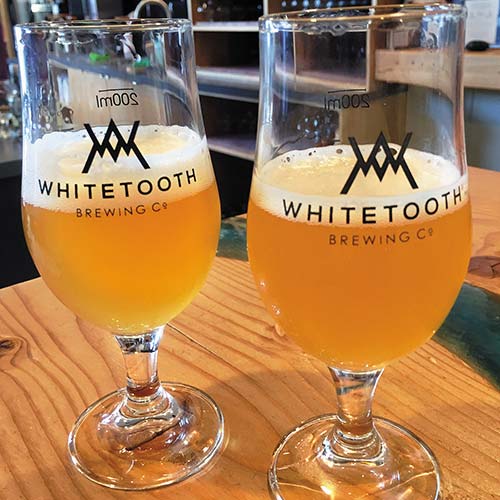
beer at Whitetooth Brewing
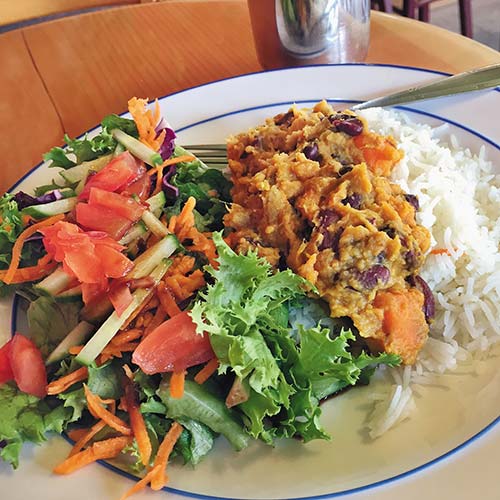
a curry plate at Jita’s Café
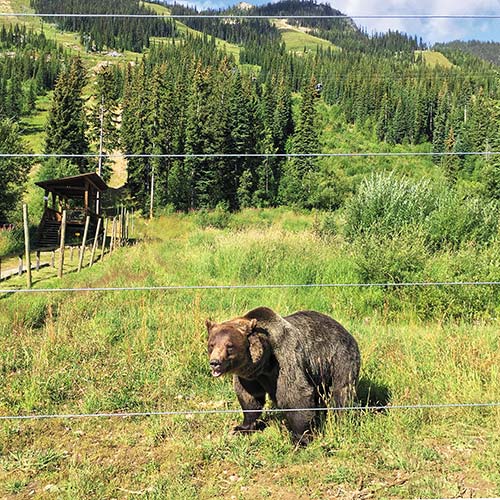
Grizzly Bear Interpretive Centre at Kicking Horse Mountain Resort
Stocking new and used books, Bacchus Books & Café (409 9th Ave. N., 250/344-5600, www.bacchusbooks.ca, 9am-5:30pm Mon.-Sat., 10am-5:30pm Sun., $5-13) also has a 2nd-floor eatery. Stop for coffee and pastries or soup and a sandwich; there’s a rack of magazines to peruse while you munch.
Tiny Golden Farmers Market (www.goldenfarmersmarket.com, noon-5pm Wed., 10am-3pm Sat. mid-June-Sept.) has two downtown locations selling fresh fruits and vegetables, baked goods, and crafts. The Saturday market is in Spirit Square, next to the Kicking Horse Pedestrian Bridge (8th Ave. N.); on Wednesday, the market sets up in the parking lot next to the Kicking Horse Chamber of Commerce building (500 10th Ave. N.).
Most of Golden’s chain motels are along or just off Highway 1. More accommodations are available at Kicking Horse Mountain Resort, a 15-minute drive from the town center.
The owners of Glacier Raft Company operate the 10-room Whitewater Lodge (1509 Lafontaine Rd., 877/344-7238, www.whitewaterlodge.com, $169-199), with log walls, a games room, and a comfortable lounge. Rates include Wi-Fi and a hearty hot breakfast. You don’t have to book a rafting trip to stay here, but if you do want to get out on the water, ask about raft-and-stay packages. No kids under 14 are allowed.
High on a hill off Highway 95 south of town, the S Cedar House Chalets (735 Hefti Rd., 250/290-0001, www.cedarhousechalets.com, $220-350) are seven contemporary wood-frame cottages, ranging from one to three bedrooms, on 10 acres of forested land. All units have woodstoves, private hot tubs, and decks with barbecues, and they’re stocked with board games, flat-screen TVs, and DVD players. The smallest unit, the romantic Adventure Chalet, has a loft bed; the high-ceilinged three-bedroom Mountain View Chalet has the best mountain vistas. Wi-Fi and phone calls (local, national, and even international) are included in the rates. You can have dinner on-site at the Cedar House Restaurant.
Jo-Anne and Dave Best came from the UK to ski western Canada’s mountains. Their ski holiday turned permanent when they settled on a 68-acre (28-ha) property south of Golden, where they keep horses and rent out three upscale self-catering cottages. The secluded Mount 7 Lodges (891 Crandall Rd., 250/344-8973 or 888/344-8973, www.mount7lodges.com, $250-460 for 2-8 people), all built using local wood, include the two-bedroom Deer Lodge, the three-bedroom, two-bath Bear Lodge, and the four-bedroom, four-bath Eagle Lodge. All have open-plan living rooms, full kitchens, private hot tubs, and Wi-Fi included.
Located along the Kicking Horse River at the east end of town, Golden Municipal Campground (1411 9th St. S., 250/344-5412 or 866/538-6625, www.goldenmunicipalcampground.com, June-Oct., $35 tent sites, $38-42 electrical sites) has 72 campsites, including 32 with power. There are showers, laundry facilities, and included Wi-Fi.
Tourism Golden (www.tourismgolden.com) operates the seasonal Golden Visitor Centre (1000 Trans-Canada Hwy., 250/439-7290, 9am-7pm daily June-mid-Sept., 10am-5pm daily mid-late Sept.), where staff can answer your travel questions. The organization also provides regional information on its website, which has an online trip-planning tool.
The Golden & District Hospital (835 9th Ave. S., 250/344-5271, www.interiorhealth.ca) has a 24-hour emergency room. Gourlay’s Golden Pharmacy (826B 9th Ave. S., 250/344-8600, www.pharmachoice.com, 9am-5pm Mon.-Fri.) and Golden Family Pharmacy (1104 10th Ave. S., 250/344-6821, www.pharmachoice.com, 9am-6pm Mon.-Sat., 10am-4pm Sun.) fill prescriptions and sell medical supplies.
At Kicking Horse Mountain Resort (1500 Kicking Horse Trail, Golden, 250/439-5425 or 866/754-5425, www.kickinghorseresort.com), a mountain playground just outside Golden, there’s plenty to do in both summer and winter. The resort is set in the Purcell Mountains, surrounded by the peaks of the Rocky and Selkirk Ranges.
To reach Kicking Horse Mountain, from Highway 95 (10th Ave. N.) in Golden, take 7th Street North toward the river, where it turns right and joins Kicking Horse Drive. Kicking Horse Drive crosses the river, becomes Kicking Horse Trail, and leads up the mountain to the resort, 9 miles (14 km) from Golden.
For information about all the summer activities at the resort, contact the Kicking Horse Mountain Activity Centre (250/439-5425 or 866/754-5425, www.kickinghorseresort.com) at the mountain base.
In summer, you can ride the Golden Eagle Express Gondola (10am-2:30pm daily late May-late June, 10am-4:30pm daily late June-Aug., 10am-3pm Mon.-Thurs., 10am-4pm Fri.-Sun. Sept., adults $40.95, seniors and ages 13-17 $34.95, ages 6-12 $19.95, families $94.95) to the mountain summit for sightseeing, hiking, or a meal at the Eagle’s Eye Restaurant.
Even if you don’t spot bears in the wild as you travel across western Canada, you can get close to a grizzly at Kicking Horse Mountain. At the Grizzly Bear Interpretive Centre (10am-2pm Mon.-Thurs., 10am-4pm Fri.-Sun. late May-Sept., adults $29.95, seniors and ages 13-17 $24.95, ages 6-12 $14.95, families $69.95), a mountainside bear sanctuary, Boo, an orphaned grizzly bear born in 2002 in B.C.’s northern Cariboo region, roams a 20-acre (8-ha) habitat. You can watch the omnivorous Boo digging, foraging, and munching on seeds, fruits, meat, or sometimes field mice that he hunts. He needs to chow down throughout the summer to reach his average hibernation weight of 750 pounds (340 kg).
Learn more about bears and their habits on one-hour interpretive tours, which run on the hour beginning at 10am (there’s no 1pm tour). The best time to visit is in the morning, when Boo is likely to be most active.
To reach the bear reserve, take the Catamount Chairlift from the mountain base. You can purchase tickets for the bear reserve alone (which includes access via the chairlift), or buy an Adventure Pass (adults $45.95, seniors and ages 13-17 $38.95, ages 6-12 $22.95, families $106.95) that includes access to the reserve as well as a sightseeing gondola.
From the top of the Golden Eagle Express Gondola, you can access several hiking trails, from the relatively easy 20- to 30-minute CPR Ridge Walk, which has several lookout points across the mountains, to the challenging Terminator Ridge Hike up to the T2 Summit. Get hiking information and trail maps online or from the resort’s Activity Centre.
The Kicking Horse Via Ferrata (late June-Sept.) is a great adventure, an “iron way” route that enables nonclimbers to experience alpine climbing. The one-hour Pioneer Route (adults $85, ages 13-17 $75, families $285) is a good starting point if you’ve never experienced a Via Ferrata. For more of a challenge, try the two-hour Discovery Route (adults $135, ages 13-17 $125, families $419) or the longer Ascension Route (adults $175, ages 13-17 $165, families $570), which typically takes 3-4 hours.
Advance reservations are required; call or check the website for specific tour times. No rock-climbing experience is necessary for any of these routes, although you should be generally fit and comfortable with heights.
Kicking Horse Mountain’s 31 mountain biking trails (full-day adults $54.95, seniors and ages 13-17 $40.95, ages 6-12 $26.95, families $127.95), accessed from the Golden Eagle Express Gondola (10am-4:30pm daily late June-Aug., 10am-4:30pm Fri.-Sun. Sept.) or the Catamount Chairlift (10am-4pm daily late June-Aug., 10am-4pm Fri.-Sun. Sept.), make up the highest bike park in North America. The trails range from beginner to expert, and both equipment rentals and lessons are available.
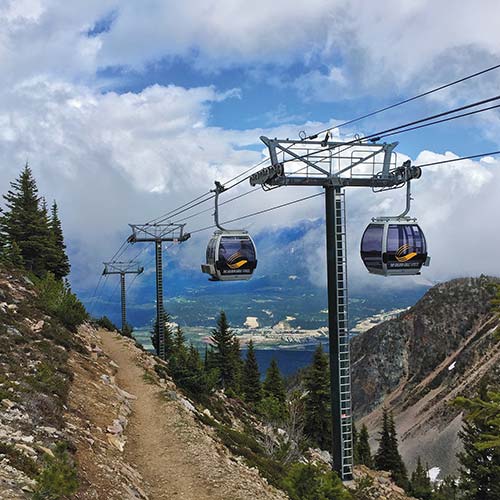
Golden Eagle Express Gondola
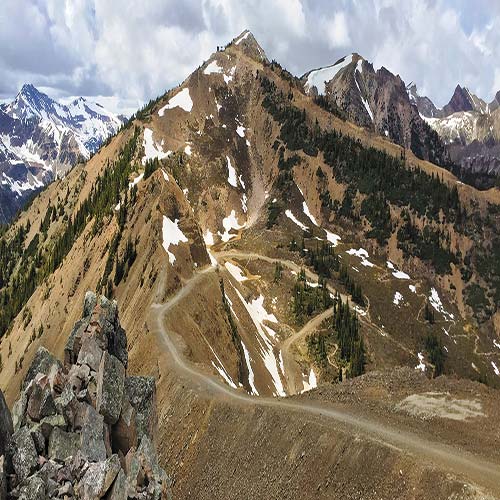
views from the top of the Kicking Horse gondola
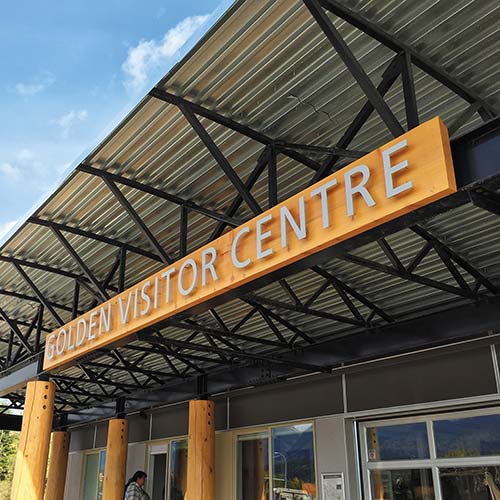
Golden Visitor Centre
Kicking Horse Mountain Resort is known for the powder conditions on its 120-plus skiing and snowboarding runs (one-day adults $109.95, seniors $88.95, ages 13-17 $82.95, ages 6-12 $43.95). The mountain covers more than 3,400 acres (1,375 ha), with the fourth-highest vertical drop in North America (4,314 ft/1,314 m). Sixty percent of the terrain is rated “advanced” or “expert.” The winter season typically runs mid-December-mid-April.
It’s Canada’s highest restaurant: At the top of the gondola station on Kicking Horse Mountain, S Eagle’s Eye Restaurant (250/439-5425 or 866/754-5425, www.kickinghorseresort.com, lunch $18-33) perches at 7,700 feet (2,347 m). Whether you ride up in summer to take in the sweeping mountain views (they’re great from the picture windows inside and even better from the outdoor patio), or stop to refuel between ski runs in the winter, the creative plates aren’t typical ski-café fare. Dig into dishes like grilled chicken panini with bacon jam, a meal-size salad of greens, fruits, candied nuts, and smoked salmon, or Alberta rib eye with peppercorn gravy. The restaurant is open for lunch during both the summer and winter seasons and for dinner ($26-48) on Friday and Saturday evenings December-March; call or check the website for hours. Note that you need to purchase a lift ticket to get to the restaurant; gondola and meal packages are available.
At the gondola base, the Double Black Café (www.kickinghorseresort.com, 9am-5pm daily, $5-15) sustains you for your mountain adventures with breakfast sandwiches, hot soup, muffins, gelato, and coffee. Sit on the patio outside or at the window-facing counters indoors, which both look out to the slopes.
Rates at the resort’s lodgings are highest during the winter months (Dec.-Mar.), so they can be a good value for a summer stay.
Kicking Horse Lodging (250/439-1160 or 877/754-5486, www.kickinghorselodging.com) manages several accommodations at the resort, including Glacier Mountaineer Lodge (1549 Kicking Horse Trail, $169-339 d, 2-bedroom suite $269-379), homey condos just steps from the gondola. In addition to standard hotel rooms, the building has one- and two-bedroom suites with full kitchens, washer-dryers, gas fireplaces, included Wi-Fi, and comfortable lodge-style furnishings. While you might prefer to overlook the ski runs, even the units facing away from the slopes have views to the more distant surrounding mountains. The outdoor hot tub, sauna, and steam room are popular après-ski.
The most surprising place to stay in the Golden area might be at the top of the Kicking Horse Mountain gondola station, where two private suites at the Eagle’s Eye (250/439-5425 or 866/754-5425, www.kickinghorseresort.com, $900-1,500), above the restaurant of the same name, let you lodge in romantic seclusion at 7,700 feet (2,347 m) elevation. Yes, it’s wildly expensive, but rates include a personal butler to pamper you and a private chef to prepare your meals. In winter, you have a private ski guide to show you the best runs, and since you’re already at the top of the gondola when the lifts open, you can get into the powder before anyone else. The suites themselves are homey, rather than over-the-top upscale, with pine walls and modern baths, but their views of the mountain peaks are priceless.
As you drive through British Columbia’s mountain regions, it’s hard to imagine that each place you visit could be more stunning than the next. But when you reach Yoho National Park, hugging the provincial boundary between B.C. and Alberta, you have to conclude that the scenery is spectacular. How fitting that the park’s name comes from a Cree expression for “wonder” and “awe.”
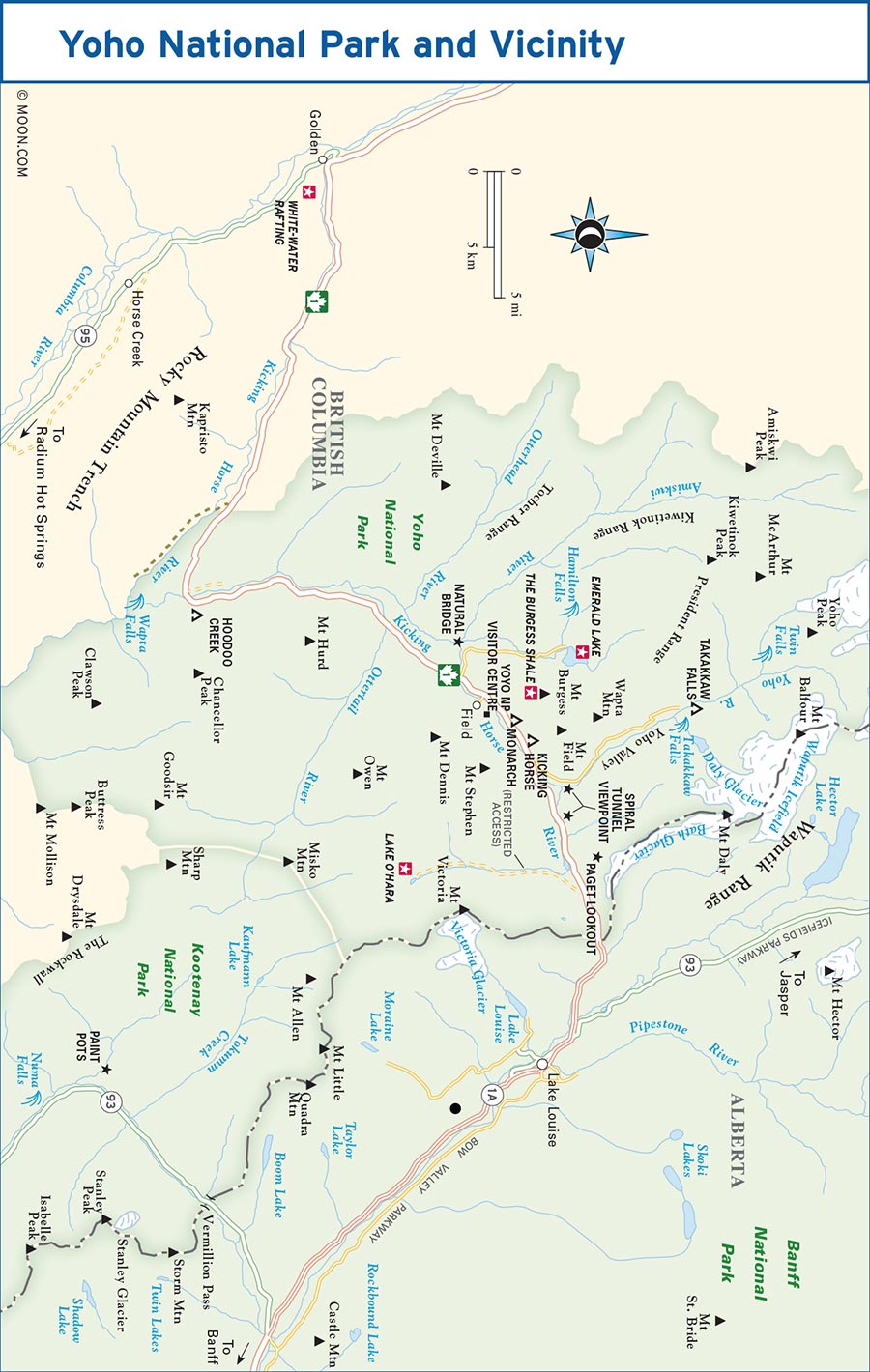
Yoho National Park covers 507 square miles (1,310 sq km) on the western slopes of the Canadian Rockies, between Golden and Lake Louise. More than 30 mountains within the park rise to nearly 10,000 feet (3,000 m). Established in 1886, Yoho now protects stunning glacial lakes, some of Canada’s highest waterfalls, and fossil beds that are among the world’s oldest. A popular destination for hikers, Yoho also played an important role in Canada’s railroad history.
Yoho National Park is open year-round, although many park services, including the visitors center and the park’s campgrounds, are available only April or May-mid-October, and several destinations can remain snow-covered into June. Due to the risk of avalanches, Yoho Valley Road, which leads to Takakkaw Falls, is usually open only mid-June-mid-October.
The tiny town of Field is near the center of the park. The park visitors center is here, as are a couple of restaurants, a small grocery, a gas station, and an inn. Beyond Field, the park has limited services.
Yoho’s western entrance is along Highway 1, east of Golden. There’s no park entrance gate, so if you’re coming from the west, buy your park pass online or at the Golden Visitor Centre (1000 Trans-Canada Hwy., 250/439-7290, www.tourismgolden.com).
Yoho’s eastern entrance is also along Highway 1, west of Lake Louise. If you’re coming from the east, you can purchase a park pass online or at the Lake Louise Visitor Information Centre (Samson Mall, Lake Louise, 403/522-3833, www.banfflakelouise.com).
The Yoho National Park Visitor Centre in Field is at the approximate midpoint of the park.
Highway 1 runs through Yoho National Park. If you’re driving through without stopping, a park pass isn’t required. However, you need a pass if you get out of your car anywhere within the park boundaries.
A Yoho day pass (adults $9.80, seniors $8.30, families $19.60) is valid until 4pm on the day after you purchase it. Yoho passes can be used at Mount Revelstoke, Glacier, and Kootenay National Parks in B.C. and at Banff, Jasper, Waterton Lakes, and Elk Island National Parks in Alberta.
Purchasing a Parks Canada annual discovery pass (adults $67.70, seniors $57.90, families $136.40), valid for a year, is a good deal if you’re spending at least a week in one or more parks. It’s good at more than 100 national parks and national historic sites across Canada. You can buy an annual pass online from Parks Canada (www.pc.gc.ca) or at any park visitors center.
For both day and annual passes, family passes cover up to seven people arriving together in a single vehicle, whether or not they’re actually related.
The Yoho National Park Visitor Centre (Hwy. 1, Field, 250/343-6783, www.pc.gc.ca, 8:30am-7pm daily June-Sept., 9am-5pm daily Apr.-May and early-mid Oct.) is in the town of Field, near the center of the park. Travel Alberta (800/252-3782, www.travelalberta.com), the provincial tourism agency, maintains an information desk in the visitors center, which is useful if you’re traveling east. Also in the visitors center, the Friends of Yoho National Park (250/343-6393, www.friendsofyoho.ca) run a gift shop and organize special events.
When the Yoho National Park Visitor Centre closes for the season, the nearest information center is the Lake Louise Visitor Information Centre (Samson Mall, Lake Louise, 403/522-3833, 8:30am-7pm daily June-Sept., 9am-5pm daily Oct.-May), 17 miles (27 km) east of Field.
Most of Yoho National Park’s campgrounds are first-come, first-served and do not take reservations; the Lake O’Hara campground is reservations-only. Visiting Lake O’Hara and touring the Burgess Shale fossil beds both require advance reservations and careful attention to the reservations procedure and deadlines.
The Yoho National Park Visitor Centre (Hwy. 1, Field, 250/343-6783, www.pc.gc.ca, 8:30am-7pm daily June-Sept., 9am-5pm daily Apr.-May and early-mid Oct.), a basic grocery, and a gas station are located in the town of Field.
Yoho National Park currently has no cell phone coverage; you might get a signal in Field but not elsewhere in the park. The park has no Wi-Fi, although the lodges offer Internet access for guests.
Outside the park, the nearest town is Lake Louise, which has a small food market, gas stations, park information, and a medical clinic. Lake Louise is 17 miles (27 km) east of Field via Highway 1. For more services, go to Golden, 35 miles (56 km) to the west, or Banff, 55 miles (85 km) to the east.
Except for the buses to Lake O’Hara, which are available only with required advance reservations, there is no public transportation within the park.
If you’re planning to follow Yoho Valley Road toward Takakkaw Falls, note that RVs and trailers are not permitted on this road after the 6-kilometer mark. A short section of very steep, narrow switchbacks at this point make it impassable for large vehicles.
One of the most beautiful areas of Yoho National Park is also one of the most challenging to reach—not because getting to Lake O’Hara, which is surrounded by meadows, mountain peaks, and dozens of smaller alpine lakes, requires an arduous journey, but because Parks Canada has limited visitor access to this wildly popular area. A visit requires careful advance planning.
Private cars are not allowed on the Lake O’Hara road, so for day visitors, the only way to visit is on the Parks Canada shuttle bus or by hiking in 7 miles (11 km) from the Lake O’Hara parking lot, which is 8 miles (13 km) east of Field and 7.5 miles (12 km) west of Lake Louise.
To take the Parks Canada shuttle bus (mid-June-early Oct., round-trip adults $14.70, ages 6-16 $7.30), you must make advance reservations (519/826-5391 or 877/737-3783, www.reservations.parkscanada.gc.ca) online or by phone in early spring for the coming season. Typically, reservations for the entire season sell out on the first day they become available. Check the Parks Canada website (www.pc.gc.ca) for reservation instructions, and be ready to make your booking as early as possible.
While reservations aren’t required to return from the lake, pay attention to the bus schedule, as there are just a few departures per day, and you don’t want to miss the last bus.
If you aren’t able to reserve a shuttle spot, you can hike to the lake on the access road. You might be able to buy a one-way ticket (adults $9.75, ages 6-16 $4.75) to return from the lake on the bus, but only if space is available. If you choose to hike, be prepared to hike both ways.
Once you’ve managed to get to the lake, it’s a great destination for day hikes, from easy strolls to more adventurous mountain treks.
One of the easier routes is the scenic Lake O’Hara Shoreline Trail, a 1.7-mile (2.8-km) loop. The Lake Oesa Trail, 2 miles (3.2 km) each way, starts on the Lake O’Hara Shoreline Trail, before climbing to a cliff overlooking the lake; the elevation gain is 787 feet (240 m). The 3.7-mile (5.9-km) Opabin Plateau Circuit takes you to a hanging valley on top of a cliff above Lake O’Hara, with an elevation gain of 820 feet (250 m).
Get a more detailed description of these and all the Lake O’Hara trails on the Yoho National Park website (www.pc.gc.ca) or from the Yoho National Park Visitor Centre.
Unlike the rest of the Yoho campgrounds, where you can’t make a reservation, you can stay overnight at the 30-site Lake O’Hara Campground (mid-June-Sept., $9.80) only by reservation. You’ll have to be on the ball to book a campsite; all sites are usually reserved on the first morning that they become available, three months in advance.
To reserve a Lake O’Hara site, you must phone the Yoho National Park reservation line (250/343-6433, 8am-noon and 1pm-4pm mountain time Mon.-Fri. Apr.-late May, 8am-noon and 1pm-4pm daily late May-mid-June, 8am-noon and 1pm-4pm Mon.-Fri. mid-June-early Oct., reservation fee $11.70) exactly three months before your desired stay. You can book a site for up to three nights.
When you make your camping reservation, you also reserve a spot on the Parks Canada shuttle bus (adults $14.70, ages 6-16 $7.30). The amount of luggage you can bring is restricted, so check the details on the Yoho National Park website (www.pc.gc.ca).
A stay at the remote Lake O’Hara Lodge (250/343-6418 or 403/678-4110, www.lakeohara.com, mid-June-early Oct. and late Jan.-early Apr., $705-795 d, cabins $995), built in 1926, takes you off the grid near the scenic lake. The eight rooms in the rustic main lodge each have two twin beds and share two large baths. In the summer or fall, you can stay in a log cabin with a private bath; some are on the lakeshore, while others (with a sofa bed and a Murphy bed to accommodate up to 4) are on a knoll above the lake.
Rates include three meals a day, afternoon tea, and transportation to the property on the lodge’s private shuttle. Since no private cars are allowed on the Lake O’Hara road, guests catch the shuttle at the Lake O’Hara parking lot off Highway 1; it departs twice a day in each direction.
Emerald Lake is as beautiful as its name suggests, its waters shimmering light green, turquoise, and deep emerald as the sunlight bounces off the mountains and moves across the sky and behind the clouds. It’s one of the park’s most visited spots, with tour buses disgorging hordes of visitors who snap photos and hop back on their buses. But stay awhile. You can follow an easy trail around the lake and leave many of the other visitors behind, or rent a canoe to go for a paddle and admire the surrounding cliffs.
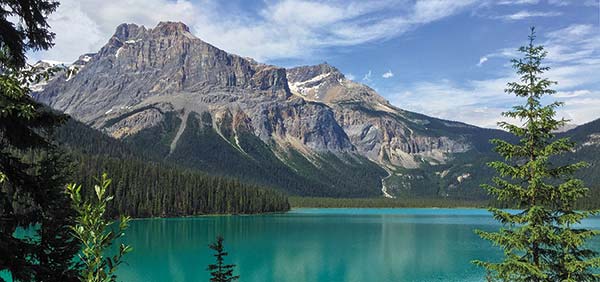
Emerald Lake in Yoho National Park
The 3.25-mile (5.2-km) mostly flat Emerald Lake trail leads through the forest around the lake. Allow about two hours for a leisurely lake circuit.
From a lakeside boathouse, Emerald Sports (250/343-6000, www.khsc.ca) rents canoes and rowboats (10am-5pm daily May-June and Sept.-Oct., 9am-7pm daily July-Aug., $70 per hour) spring-fall. In winter it rents snowshoes (noon-4pm Mon.-Fri., 10am-4pm Sat.-Sun. Dec.-Mar., $10 per hour, $5 per additional hour, $20 per day) and cross-country skis ($15 per hour, $5 per additional hour, $25 per day).
Overlooking the lake, Emerald Lake Lodge (250/343-6321, www.crmr.com) has several restaurants that are open to nonguests. You can also picnic near the lake.
To reach Emerald Lake, follow Emerald Lake Road off Highway 1, west of Field. Try to visit early in the morning or late in the afternoon, when the crush of visitors may have lessened slightly.
On your way to Emerald Lake, stop to see the Natural Bridge (Emerald Lake Rd.), an unusual rock formation on the Kicking Horse River with a swirl of water rushing through it. Surrounded by mountain peaks and pines, the natural bridge is a scenic spot for photos. Several hiking and cycling trails start nearby, including the 2.3-mile (3.6-km) Kicking Horse-Amiskwi Trail and the 7.8-mile (12.6-km) Kicking Horse-Otterhead Trail, which both follow old fire roads.
One of the highest waterfalls in Canada, Takakkaw Falls (Yoho Valley Rd.) is 833 feet (254 m) tall. The falls, which cascade down a rock face in the Yoho Valley, are especially lovely late in the day when the afternoon or early evening sun illuminates the water. A short walking trail leads from the parking area to the base of the falls.
To reach the falls, follow Yoho Valley Road off Highway 1; the falls are 11 miles (18 km) northeast of Field. Because Yoho Valley Road has a short section of steep, narrow switchbacks, RVs and other large vehicles are not permitted to continue on this road beyond the switchbacks.
To complete the transcontinental railroad that would link Canada’s Pacific coast with its eastern regions, Canadian Pacific Railway engineers needed to find a route across the Rocky Mountains. The route they chose, through the Kicking Horse Pass, required a precipitous descent—four times steeper than the average rail grade at the time—on what became known as the “Big Hill.”
Unfortunately, climbing and descending the Big Hill, which is in present-day Yoho National Park, turned out to be complicated and dangerous. The first train that tried to travel through the pass derailed, killing three workers. Engineer J. E. Schwitzer eventually came up with a solution: the Spiral Tunnels, two looping tracks that allowed trains to make a more gradual descent. Completed in 1909, these tunnels are still in use.
You can watch trains enter and leave these unusual tunnels from two viewpoints. From the Lower Spiral Tunnel Viewpoint (Hwy. 1, 4.7 mi/7.5 km east of Field), you can see trains pass through the tunnel on Mount Ogden. From the Upper Spiral Tunnel Viewpoint (Yoho Valley Rd., 1.5 mi/2.3 km from Hwy. 1), you can watch the tunnel through Cathedral Mountain.
While an average of 25 trains pass through the tunnels every day, the schedule is irregular, but if you’re lucky, you’ll get to see a train make its looping way through this engineering innovation.
In 1909, American geologist Charles Walcott made a surprising discovery in the mountains near the town of Field. The well-preserved fossils that he unearthed were the remains of soft-bodied marine organisms that once lived in the Cambrian Sea in what is now Yoho National Park. Among the world’s oldest fossils, they’re estimated to be 505 million years old.
The area where Walcott discovered the fossils, known as the Burgess Shale, encompasses layers of fossil-filled rocks on Fossil Ridge between Wapta Mountain and Mount Field. To recognize the importance of its geological legacy, the Burgess Shale has been designated a UNESCO World Heritage Site.
The Yoho National Park Visitor Centre (Hwy. 1, Field) has an exhibit where you can learn more about the Burgess Shale fossils.
Park visitors can tour the Burgess Shale fossil beds on a full-day guided hike, which you must reserve in advance. Make reservations with Parks Canada (877/737-3783, www.reservations.parkscanada.gc.ca, reservations fee $11 online, $13.50 by phone), beginning in early January for the coming season. Check the website to confirm when reservations will become available and book as early as possible. You can choose from two different guided Burgess Shale hikes in Yoho National Park. There’s also a guided Burgess Shale hike in Kootenay National Park.
One of the guided hikes is to Walcott Quarry (daily early July-early Sept., Fri.-Sun. early-mid Sept., adults $70, seniors $59.50, ages 8-16 $35). You need to hike a challenging trail, a 13-mile (21-km) round-trip route with an elevation gain of 2,710 feet (825 m). Parks Canada staff caution that this elevation change is the equivalent of climbing up and down the stairs in a 234-story building. Along the way, as you traverse the striking mountain scenery, your guide will explain more about the Burgess Shale, the fossils and their importance, and local wildlife. Hikes depart from the Takakkaw Falls parking lot on Yoho Valley Road at 7am; expect to be on the trail for 10.5 hours.
An alternate guided hike takes you to the Mount Stephen Fossil Bed (Sat.-Mon. mid-June-early Sept., adults $55, seniors $46.75, ages 8-16 $27.50), where railroad workers found fossils even before Walcott made his groundbreaking discovery. This seven-hour hike is shorter but steeper than the Walcott Quarry hike, with an elevation gain of 2,610 feet (795 m) on a 5-mile (8-km) round-trip hike. This hike departs from the Yoho National Park Visitor Centre, off Highway 1 in Field, at 7am.
The small town of Field, in the center of Yoho National Park, was settled in the 1880s when the Canadian Pacific Railway was built through Kicking Horse Pass. Originally a service center for the trains climbing the Big Hill, the town began developing tourist infrastructure when the Mt. Stephen House hotel opened in 1886. In the early 1900s, up to 12 passenger trains passed through Field each day.
Though the Mt. Stephen House is no longer standing, another town landmark is: the CPR Water Tower, which was built in 1930 to supply the steam trains with water. The 70-foot (21-m) tower was retired in 1952 when diesel engines replaced their steam counterparts.
In summer, the Friends of Yoho National Park offer one-hour historic walking tours of Field (250/343-6393, www.friendsofyoho.ca, 8pm Tues. and Thurs. July-Aug., free) that depart from the Field Community Centre (315 Stephen Ave.), near the water tower. If you prefer to wander on your own, you can get a copy of the Friends’ historic map of Field online or at the park visitors center.
With more than 250 miles (400 km) of hiking trails, Yoho has plenty of options for hikers of all levels.
Near the park’s western boundary, 16 miles (26 km) west of Field, the Wapta Falls Trail is a moderate hike with a big payoff: up-close views of the largest waterfall on the Kicking Horse River.
Most of the 2.9-mile (4.6-km) round-trip trail is fairly easy, with gentle ups and downs. Just above the first point where the falls come into view, the trail switchbacks down more sharply, but your reward from the next viewpoints is a full-on view of the falls with rocky peaks beyond. Then you can descend another short segment to the riverbank, where you’ll be close enough to Wapta Falls, which is 98 feet (30 m) high and 490 feet (150 m) wide, to feel its spray.
To see a series of hoodoos, pillar-like rock formations created from glacial debris, follow the steep Hoodoos Trail, which begins in the Hoodoo Creek Campground, 14 miles (23 km) west of Field off Highway 1. This 3.2-mile (5.2-km) round-trip trail climbs steeply, with an elevation gain of 1,066 feet (325 m), so take it slow and allow at least 2.5 hours for the hike.
The mostly forested Twin Falls Trail (mid-June-mid-Oct.), leading to the 260-foot (80-m) waterfall of the same name, begins at the Takakkaw Falls parking lot on Yoho Valley Road, 10.5 miles (17 km) northeast of Field. This hike is 10.2 miles (16.4 km) round-trip, with an elevation gain of 985 feet (300 m); allow approximately six hours.
One of the most popular all-day hikes in Yoho National Park, the challenging 13-mile (21-km) round-trip Iceline Trail rewards hikers with spectacular glacier views before climbing down through meadows in the Little Yoho Valley and past Laughing Falls. With a 2,329-foot (710-m) elevation gain, this trail takes most hikers about eight hours.
For a slightly shorter hike, follow an alternate Iceline route to Celeste Lake, a 10.9-mile (17.5-km) round-trip route with a 2,280-foot (695-m) elevation gain. This variation still takes about seven hours.
The trailhead for the Iceline Trail is near the Whiskey Jack Hostel. Park nearby at the Takakkaw Falls parking lot, on Yoho Valley Road, 10.5 miles (17 km) northeast of Field.
Yoho National Park has two upscale lodges, both of which have dining rooms open to nonguests. The park also has a rustic hostel near Takakkaw Falls. In the town of Field, within the park boundaries, there’s a small inn with a restaurant, and many homeowners rent rooms to guests. If you can’t find accommodations in the park, or if you want other lodging options, consider staying in Golden or Lake Louise and making day trips to Yoho.
Why stay at the remote HI-Yoho National Park Whiskey Jack Hostel (Yoho Valley Rd., 778/328-2220 or 866/762-4122, www.hihostels.ca, late June-Sept., $30 dorm), a rustic cabin with no electricity? Because you can step onto the porch for views of nearby Takakkaw Falls or easily access several excellent hiking routes, including the Iceline Trail, which begins right at the hostel. Guests share three bunk rooms, each outfitted with nine beds and a small private bath with a flush toilet and hot shower. Propane powers the lamps and the appliances in the shared kitchen. Bring food and a flashlight, and charge your batteries before you arrive. The hostel has no phone, cell service, or Wi-Fi.
You can’t ask for a lovelier setting than that of S Emerald Lake Lodge (Emerald Lake Rd., 800/663-6336, www.crmr.com, $209-525), on the shores of the gorgeous green lake. The property has 85 comfortable, though not luxurious, guest rooms in 37 cabins; many cabins have two units on the main level and two upstairs. With standard rooms, studios, and one-bedroom suites, the accommodations all have fireplaces and balconies, with natural wood furnishings and fans but no air-conditioning. The Club House has a hot tub, a sauna, and a small gym, while the main lodge, constructed from hand-hewn wood, has a restaurant, a lounge, and a 2nd-floor games room with the second-oldest snooker table in Canada. Expect to disconnect while you’re here: Wi-Fi is available in the main lodge only.
Emerald Lake Lodge has several dining options, open to both guests and nonguests. The more formal Mount Burgess Dining Room (250/343-6321, 7am-11am and 5:30pm-9:30pm daily, breakfast $15-23, dinner $32-45) overlooks the lake; it’s known for game meats like elk or bison steak. In the casual Kicking Horse Lounge (11am-10pm Sun.-Thurs., 11am-11pm Fri.-Sat., $17-25), you can order from the dining room menu or from a lighter lounge selection, including a signature charcuterie plate for two. In summer, you can have drinks or lunch (salads, burgers, pizza, and sandwiches) at Cilantro on the Lake (11am-5pm daily June-Sept., $17-25), on the water near the bridge to the property. Cilantro’s take-out window (10am-5pm daily June-Sept.) sells ice cream, coffee, and cold drinks.
What’s more Canadian than a stay in a log cabin? At S Cathedral Mountain Lodge (Yoho Valley Rd., 250/343-6442 or 866/619-6442, www.cathedralmountainlodge.com, late May-early Oct., $366-855), which has 31 upscale cabins near the Kicking Horse River, you don’t have to rough it to live out your log-cabin dreams. Cabins are furnished with custom log beds, down duvets, soaker tubs, and porches with Adirondack chairs. Premier units have stone fireplaces and mini fridges. Five units can sleep up to four people; family cabins have a king bed on the main floor and a loft with two twins. Originally built in the 1930s to accommodate railroad workers and miners, the high-ceilinged, wood-framed main lodge building now houses the Riverside Dining Room, which serves a buffet breakfast (7am-10:30am daily, included in the room rates) and dinner (5:30pm-9:30pm daily, $29-46) to guests and nonguests. Guests can order a packed lunch ($36 for 2 people) to take on park adventures. The lodge is located 0.6 mile (1 km) from Highway 1. The only minor quibble with the otherwise serene setting is that you can sometimes hear the distant traffic hum.
A list of rooms to rent (www.field.ca, $140-450) in private homes in the town of Field is available online. Book early, especially if you’re visiting in July and August, as availability is limited.
Truffle Pigs Bistro and Lodge (100 Center St., 250/343-6303, www.trufflepigs.com, Dec.-Oct.) runs a well-loved restaurant (11am-3pm and 5pm-9pm daily May-Sept., call for off-season hours, lunch $17-22, dinner $17-38) in a post-and-beam mountain lodge, where you can lunch on pulled pork bao; a veggie burger made of beets, millet, and sweet potato; or salads like “Got Rhubarb,” with marinated rhubarb and fennel, arugula, and grilled halloumi cheese. The inventive dinner mains could include pappardelle with pumpkin seed pesto, pork tenderloin with roasted pistachios, or salmon with bulgur tabbouleh and dill sour cream. If you want to crawl under the covers after your meal, the lodge ($145-285) has 13 guest rooms with queen beds, mini fridges, microwaves, private baths, and included Wi-Fi.
In a cozy yellow house, funky Siding Café (318 Stephen Ave., 250/343-6002, www.thesidingcafe.ca, 10am-5pm daily, longer hours in summer, $8-15) serves breakfast, burgers, sandwiches, and a tasty rice bowl with tofu, spinach, beets, and carrots sauced with a garlicky tahini dressing. It’s also the town’s liquor store.
At Yoho’s four main campgrounds, sites are first-come, first-served, so arrive early in the day, especially in July and August. It’s possible to camp mid-May-mid-October, although not all campgrounds remain open during the entire period.
The centrally located 88-site Kicking Horse Campground (Yoho Valley Rd., late May-mid-Oct., $27.40) is the park’s largest camping area and the only one with flush toilets and showers. Nearby, Monarch Campground (May-early Sept., $17.60) has 44 sites.
Near the waterfalls of the same name, Takakkaw Falls Campground (Yoho Valley Rd., late June-mid-Oct., $17.60) has 35 walk-in sites.
The 30-site Hoodoo Creek Campground (mid-May-early Sept., $15.70) is off Highway 1 near the park’s west entrance.